
ANNUAL REPORT 2022
Excellence
Integrity and passion underpin our pursuit of scientific knowledge of the highest quality, while nurturing and inspiring the next generation of scientists.
Innovation
We inspire and enable world-class researchers at the frontiers of science and medicine to find new, transformative solutions to our greatest health challenges.
Partnerships
Our collaborative research environment allows scientists to leverage partnerships for true knowledge gain and patient impact.
Community
We care deeply about improving the health and wellbeing of our community and we are committed to rewarding its investment in science.
Our values Our goals
Transformative medical research
We strive to improve the health of our community by undertaking outstanding medical research.


Enriching partnerships
We build and nurture meaningful partnerships to accelerate research discoveries to patient care.
Exceptional people and culture
We are a destination of choice, recognised for supporting and developing our staff and students.
Enabling success
We deliver a world-class research environment.
08
10
12
The silent killer: Why medical research is fired up about inflammation
14
Research impact
41
Business development and commercialisation
42
02 About us People
Thank you to our supporters
46
From the Director Graduates of 2022
56
58
Chair’s report Board of directors
60
Organisation structure
61
Financial snapshot
Postdoctoral scientist Dr Stacey Ellery and her son Archie
Photograph by Ian Currie
ANNUAL REPORT 2022 1 Cover image: L-R: Eli and Nelly See page 29 for full story.
About us
A global bioscience medical research leader, Hudson Institute advances healthcare through groundbreaking, collaborative medical research discoveries and their translation into real-world impact.
Our internationally recognised research programs deliver in five areas of medical need
• Inflammation
• Cancer
• Reproductive health
• Newborn health
• Hormones and health.
Our 457 scientists, clinicians and graduate students come from around the world to pursue one mission – to make medical research discoveries that save and change lives.
Located in the Monash Health Translation Precinct, our scientists work alongside clinical and industry colleagues and use advanced technology platforms to inform their discoveries.
Our themes
Inflammation
Uncontrolled inflammation in the immune system causes 50 per cent of deaths and underpins many chronic diseases. Our scientists are finding ways to prevent and treat inflammatory diseases.


Cancer
Every day, 400 Australians are diagnosed with cancer and 130 succumb to the disease. Our scientists are identifying better ways to diagnose, detect and treat cancers.
Our expertise spans the complete translation pipeline from patient need, scientific discovery to clinical testing and commercialising new preventative approaches, therapies and devices for patients.

Our Institute is named after Professor Bryan Hudson AO, the Founding Director of Prince Henry’s Institute, and Inaugural Chair of the Department of Medicine at Monash University.
Reproductive health
The reproductive system is central to conception, pregnancy and birth. Our scientists are working to reduce rates of infertility, stillbirth, endometriosis and birth trauma.
Newborn health

Almost one in five newborns starts life in neonatal care. Our scientists investigate the complications that can occur during pregnancy, birth, and the critical early weeks to protect vulnerable newborns.
Hormones and health
The endocrine (hormonal) system is important for most parts of your body to work. Our scientists’ goal is to find new treatments for hormonal conditions.

ANNUAL REPORT 2022 3 2 HUDSON INSTITUTE OF MEDICAL RESEARCH
Monash Health Translation Precinct
Hudson Institute is located within the Monash Health Translation Precinct (MHTP), a major scientific research and medical innovation powerhouse in Melbourne’s south-eastern corridor. With our precinct partners, Monash Health and Monash University, we are a global leader in medical research, healthcare, new technologies and education.
Our shared Translational Research Facility (TRF) brings scientists, clinicians and state-of-the-art technology together to accelerate medical research discovery through to clinical trials and into patient care. We achieve this through innovation and trusted relationships with industry and government.

MONASH UNIVERSITY (SCHOOL OF CLINICAL SCIENCES)

MONASH HEALTH MONASH CHILDREN’S HOSPITAL
At Hudson Institute
TRANSLATIONAL RESEARCH FACILITY
HUDSON INSTITUTE

We expand the boundaries of knowledge to save and change lives.
We make new scientific discoveries to improve people's health.
We collaborate with scientists and clinicians in Australia and around the world.
We help governments to improve healthcare and create jobs.
We help doctors save lives, providing insight for them to find the right clinical answers.
We provide scientific breakthroughs for development with industry.
We prepare today’s students for successful careers in science and medicine for tomorrow.
4 HUDSON INSTITUTE OF MEDICAL RESEARCH ANNUAL REPORT 2022 5
281 6 HUDSON INSTITUTE OF MEDICAL RESEARCH ANNUAL REPORT 2022 7
STAFF
Grant funding received in 2022

Research
Publication type 2020 2021 2022 Original research articles 210 188 192 Reviews 41 41 38 Editorials and commentaries 26 26 17 Books and book chapters 8 2 3 National Health and Medical Research Council 10,070,052 Medical Research Future Fund 6,833,672 Children's Cancer Foundation 1,704,680 Australian Research Council 1,276,142 Financial Markets Foundation for Children 1,000,000 Department of Jobs, Precincts and Regions (Victorian Government) 881,667 Ovarian Cancer Research Foundation 388,155 Cancer Australia 370,110 Zero Childhood Cancer Program 336,332 Victorian Cancer Agency 320,000 The Kids' Cancer Project 306,000 Robert Conner Dawes Foundation 272,543 Additional Philanthropic Funding Cerebral Palsy Alliance Cancer Council Victoria National Heart Foundation You Are My Sunshine Foundation Australian Communities Foundation Minderoo Foundation Eva and Les Erdi Charitable Foundation Canteen Additional grant funding TOTAL 190,709 138,982 114,517 102,589 100,275 99,818 75,000 71,875 1,155,843 2,049,608 International Grants Department of Defense (USA) University of Birmingham (UK) (in partnership with CCF) National Institutes of Health (USA) Other international grants TOTAL 650,795 278,025 141,566 177,079 1,247,464 TOTAL GRANT FUNDING 27,056,425 Publications In 2022, Hudson Institute’s researchers published extensively in international peer-reviewed journals. $ Zero Childhood Cancer Program Ovarian Cancer Research Foundation Financial Markets Foundation for Children Children's Cancer Foundation The Kids' Cancer Project Robert Connor Dawes Foundation Victorian Cancer Agency Cancer Australia Australian Research Council Department of Jobs, Precincts and Regions (Victorian Government) International Grants Medical Research Future Fund Additional Philanthropic Funding National Health and Medical Research Council
outputs
At a glance 176
STUDENTS 250
45 RESEARCH GROUPS RESEARCH PUBLICATIONS
From the Director

As the third year of the COVID-19 pandemic comes to a close, what are you reflecting on?
I keep returning to the importance of inflammation, not just as it relates to COVID-19, but its role in so many diseases, and the equally important part it will no doubt play in future pandemics. I’m also motivated by the incredible potential resulting from Hudson Institute’s co-location with Victoria’s largest public health service, Monash Health. Being on a hospital site means our researchers can more quickly respond to healthcare needs and likewise progress their discoveries to patients through our clinical partnerships.
What were your highlights of 2022?
I was delighted we could contribute to a feature in Good Weekend magazine shining a light on inflammation and its impact on our health. Our scientists are making a profound difference to a multitude of diseases, from cancer, lung, kidney and liver diseases to
asthma, infertility, endometriosis, neurodegenerative conditions and autoimmune diseases like diabetes, not to mention long COVID. Our plans for a National Centre for Inflammation Research (NCIR) will accelerate that progress.
What excites you about the year ahead?
I’m looking forward to seeing the latest developments in children’s cancer from our dedicated team of paediatric cancer researchers. We are proud to be a leading partner of the Victorian Paediatric Cancer Consortium (VPCC), a collaborative effort that would not exist without the vision and backing of the Children’s Cancer Foundation. There is now more hope than ever for better outcomes for children with cancer and their families.
As Director and CEO, what’s your vision for the future of Hudson Institute?
Independent medical research institutes, especially those co-located with a healthcare service, focus on
targeting research to areas of patient need. Our plan for the NCIR will focus on the rapid translation of our research discoveries in inflammation into the public sphere to enable a fast response during times of need, like a pandemic, but also to address the ever growing burden of chronic disease. This initiative is an Australian first where the investments we make today will pay us all back with tomorrow’s healthcare breakthroughs.
I can’t wait to see what we will achieve together.
Professor Elizabeth Hartland Director and CEO

“There is now more hope than ever for better outcomes for children with cancer and their families.”
Professor Elizabeth Hartland
ANNUAL REPORT 2022 9 8 HUDSON INSTITUTE OF MEDICAL RESEARCH
Chair’s report

Following another challenging year for healthcare providers everywhere, Hudson Institute can be proud of the part it continues to play in the nation’s medical research landscape.
A fine illustration is the ascension of Professor Elizabeth Hartland to the position of incoming President of the Association of Australian Medical Research Institutes (AAMRI), the peak body representing medical research institutes across Australia. Prof Hartland is an inspirational figurehead for the organisation, both as an eminent researcher and as an inspirational leader. The Board is proud and honoured that she will continue to lead the Institute for a second five-year term as our Director and CEO.
Challenges ahead
From a financial perspective, 2022 was a successful year, with healthy revenues generated and significant research grants received, despite the difficult funding environment in which the entire sector currently operates. We expect 2023 to be a challenging year financially, but we will continue to support AAMRI and our representative bodies as they lobby for further support for the research sector, which is so vital for the future health of Australians.
Partnerships bearing fruit
On the business development and commercialisation front, Hudson Institute is increasingly valued as a major partner with industry in the development, testing and production of new treatments and cures. In terms of partnerships, patents and public exposure, we are successfully exploring all avenues for bringing our research discoveries to those who would most benefit from them.
This can be seen with our recent licensing agreement with Australian clinical-stage drug development company Noxopharm Ltd, through its wholly owned subsidiary, Pharmorage Pty Ltd. This has the potential to make mRNA vaccines easier to manufacture and more effective. With the mRNA vaccines market predicted to reach US$23 billion by 2035, RNA technologies are integral to new treatments for the future.
Our partnerships with funding bodies also continue to be fruitful, and it is extremely gratifying to see the work
coming from our children’s cancer researchers and their productive partnership with the Victorian Paediatric Cancer Consortium – a concept that was made real by the hard work and dedication of the Children’s Cancer Foundation.
I acknowledge the services of Nigel Garrard on the Hudson Institute Board and regret that he has stepped down. Nigel has been a valuable Board member as well as a generous donor, and his contribution to the Board will be missed. In 2023 and beyond, we know that many lessons remain to be learned from COVID-19 and Hudson Institute will remain at the forefront of inflammation research, both in terms of the current pandemic and the health emergencies that the future will undoubtedly bring.

“We are successfully exploring all avenues for bringing our research discoveries to those who would most benefit from them.”
Dr Robert (Bob) Edgar AM Chair
ANNUAL REPORT 2022 11 10 HUDSON INSTITUTE OF MEDICAL RESEARCH
Dr Robert Edgar
The silent killer: Why medical research is fired up about inflammation
In February 2022, Good Weekend* magazine produced a feature about inflammation, showcasing the important work of our scientists. Below is an extract, published with permission by the author, Greg Callaghan.

From long COVID to Alzheimer’s, all manner of health woes are increasingly thought to have one thing in common: inflammation. But there’s an ongoing mystery: why does it go rogue in some people and not others? Great medical minds are on the case.
Long COVID is merely the latest in a big, mixed bag of diseases in which inflammation has been found to play a key role. Over the past 20 years, study after study has revealed inflammation’s contribution to heart disease, respiratory diseases like asthma, rheumatoid arthritis, Alzheimer’s disease, and autoimmune diseases like type 1 diabetes, lupus and inflammatory bowel disease, which encompasses Crohn’s disease and ulcerative colitis.
Inflammation has been shown to loosen cholesterol deposits in coronary arteries, leading to heart attacks; it’s the mechanism that wears down large and small joints in rheumatoid arthritis; it’s the engine behind the ulceration of the gastrointestinal tract in inflammatory bowel disease; it’s at the centre of the immune system attacking its own tissues in lupus sufferers; it’s at the heart of the process of T-cells attacking insulinproducing cells in the pancreas in type 1 diabetes; it’s behind the chronic pain of endometriosis; in Alzheimer’s, prolonged neuroinflammation can trigger an onset of the disease.
The word inflammation might sit a little flat on the page beside dramatic
words like cancer and heart disease, but because it’s an underlying dynamic in a host of diseases, it’s now a focus of cutting-edge medical research across the globe.
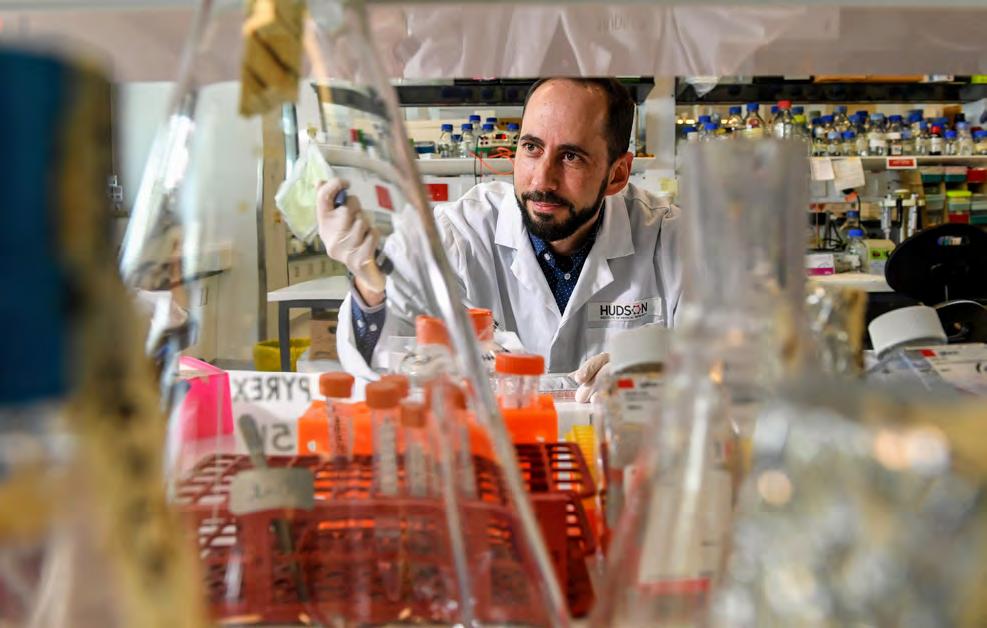
Professor Elizabeth Hartland, Director and CEO of Melbourne’s Hudson Institute of Medical Research, which houses
explains in the Good Weekend podcast chat, GW Talks. “People who have less inflammation are predicted to live longer, and people with chronic inflammation to age faster.”
When a foreign invader – a bacterium, virus or parasite – enters your body, your immune system immediately dispatches white blood cells to the injury or entry site, slowing down the march of the intruder, until wave after wave of reinforcements arrive to launch a counterattack against its spread.
The infection-fighting cells release proteins called cytokines that fuel inflammation, the trademark signs of which are heat, swelling and redness. This is the process that turns the tissue around a splinter in your finger red and hot – and it’s essential to healing.
the largest number of inflammation researchers – 150 – in Australia, contends that inflammation contributes to more than half of all deaths worldwide, and is the single biggest cause of death from COVID. “We’re not designed to withstand constant bouts of inflammation. That’s why when it becomes overblown or chronic, it can have lasting, damaging effects on the body. We need access to a better range of therapies that target inflammation when it becomes harmful.”
Scientists are now talking about an “inflammation clock”, Hartland later
Inflammation is a lifesaver – until it’s not. Occasionally, even after the unwelcome pathogen has been destroyed and the healing process is over, the inflammatory fires continue to burn away, fuelled by an immune system in overdrive. Over time, this chronic inflammation can lead to lasting damage to organs such as the lungs, heart, bowel and joints.
“Inflammation is a frontline system; it needs to be activated quickly but then should switch off when the job is done.”
The big question about inflammation is: why does it turn rogue in some people and not others? Inflammation’s tangled involvement in so many diseases explains why it’s now one of the hottest areas of medical research.
When Michael Gantier was 11, growing up in the town of Cholet in France’s picturesque Loire Valley, having his appendix removed didn’t seem like such a big deal. Then again, he had no idea of what was in store. “Unfortunately, it was a Friday afternoon, probably the worst time to get an operation,” the 41-yearold father of two says half-jokingly of the minor medical horror story he’s about to share. “After the operation, I had a temperature of 40-41 degrees and a high count of white blood cells.”
While the doctors initially dismissed this as part of his recovery from the operation, his parents, both teachers of biology in school, suspected otherwise. Suffering sepsis, a life-threatening infection of the blood, he was critically ill. “The surgeon later said I was only hours away from death.”
In the years afterwards, Gantier was plagued by stomach problems, which resulted in a diagnosis of Crohn’s disease, a debilitating condition characterised by diarrhoea, abdominal cramping, fatigue and weight loss. Both Crohn’s disease and ulcerative colitis fall under the umbrella of inflammatory bowel disease (IBD).
His experience as a child inspired him to become a doctor and scientist, and he is now a Research Group Head at Hudson Institute, working on anti-inflammatory treatments for COVID. He says any imbalance in the microbiome can influence pro-inflammatory processes in the body.
A colleague at Hudson Institute, Dr Sam Forster, who leads the Microbiota and Systems Biology Research group, compares a healthy gut biome to a pristine forest bursting with a rich variety of trees, shrubs, and flowers;
“There is a lot of association between changes in bacteria and the modification of the immune response.”
Associate Professor Michael Gantier
and an unhealthy biome to a partly cleared one, lacking in biodiversity and riddled with invasive pests and weeds. “If you have an inflammatory response from the gut, you’ll likely have an inflammatory response in other parts of the body, because our systems are interlinked,” says Forster.
The good news is that in the fight against inflammatory disease, we now live in a world of opportunity. Multiple research studies are underway at Hudson Institute. “Thanks to the focus on inflammation research over the past decade or so, we have a much richer understanding of how it behaves in our bodies”, explains Prof Hartland.
“We have more knowledge of the viral and bacterial triggers of inflammation, how cytokines act on different tissues, and the genetic basis of inflammation disorders. This has all led to new treatments.”
Until last year, there weren’t many reports of long-COVID patients making a full recovery, but that appears to be changing now that more time has elapsed. Widespread vaccination also appears to have successfully blunted long COVID: studies from the UK and the US indicate that getting a jab at least halves the risk for those infected with the earlier Alpha and Delta variants. The jury is still out on whether long COVID is less common or milder with the wildly infectious Omicron strain, but again, vaccination appears to radically reduce the risk of prolonged illness.
e.
*Good Weekend is published in The Sydney Morning Herald and The Ag
Associate Professor Michael Gantier
12 HUDSON INSTITUTE OF MEDICAL RESEARCH ANNUAL REPORT 2022 13
Research impact

14 HUDSON INSTITUTE OF MEDICAL RESEARCH ANNUAL REPORT 2022 15
Chasing bacterial evolution to safeguard human health
Most of us imagine evolution to be a slow process, with changes taking place within species over thousands of years.
Associate Professor Jaclyn Pearson is not like most of us.
In her role researching antimicrobial resistance (AMR), A/Prof Pearson sees evolution happening before her eyes.
She also sees how harmful it can be.
As a microbiologist and head of the HostPathogen Interactions research group, she studies how bacteria can evade or fool our defence systems to cause serious health problems. It is a fast-moving field.
It’s work that saw her recognised on several fronts in 2022, not least being named a Superstar of STEM. She was also one of three Australian scientists to receive a prestigious Sylvia and Charles Viertel Charitable Foundation Senior Medical Research Fellowship (worth $1.375 million over five years).

Each year, almost five million deaths are associated with drug resistant bacterial infections. That number is expected to double by 2050, so it’s no surprise that the World Health Organization calls AMR one of the top 10 global public health threats facing humanity.
A/Prof Pearson says there is an urgent need for progress, as some infections have no effective antibiotics available, leaving patients hospitalised with no treatment options.
“Major pharmaceutical companies see how quickly bacteria become resistant, so why would they want to invest in developing new antibiotics?” she says.
“Fundamental research utilising cuttingedge technology will drive long-term solutions and address the health crisis we now face due to antibiotic resistance.”
Keeping track of dangerous bacteria means knowing where they have come from and where they are heading – an approach she also takes to her career, after spending much of her 20s on the road as a drummer with the early 2000s rock band, Lash.
“Despite the opportunity to pursue music further, I have stuck with my career in research because it is exciting and compelling. At the end of my career, I want to look back and say I made a difference to someone’s life,” A/Prof Pearson says. Having benefited from great mentorship early in her career, A/Prof Pearson now wants to help the next generation.
“I moved interstate specifically to train under the supervision of Professor Elizabeth Hartland, who gave me the time, resources, and confidence to work to my strengths and become the successful leader I am today.
“I now strive to be an inspiring and kind mentor to my staff and students.
“If those I mentor continue to pursue a career in science, then I have achieved something special.”
Collaborators Monash University; Peter Doherty Institute; WEHI
Funders Australian Society for Immunology; NHMRC; Sylvia and Charles Viertel Charitable Foundation
INFLAMMATION
“My eureka moment occurred during my PhD when I saw first-hand the many ways in which bacteria meticulously target and manipulate the immune system to ‘hide’ from our defences and cause disease.”
Associate Professor Jaclyn Pearson
ANNUAL REPORT 2022 17 16 HUDSON INSTITUTE OF MEDICAL RESEARCH
Associate Professor Jaclyn Pearson
INFLAMMATION
Published in Nature Microbiology, April 2022
Published in Nature Communications, March 2022
Unlocking the mysteries of the microbiome
When it works as intended, the human gut is rarely given a thought – but that is rare luxury for the 130,000 Australians with inflammatory bowel disease (IBD), like Marisa (see next page).
That’s where Associate Professor Samuel Forster comes in.
“Our microbiome research is focused on understanding the naturally occurring bacteria we carry with us every day, and which play a critical role in keeping us healthy,” A/Prof Forster says.

“We know these hundreds of bacterial species interact with the immune systems and regulate processes such as inflammation. But we don’t yet know the ‘correct’ combination of bacteria for anyone at any particular time, or how to maintain it. “
he collaborates closely with Paediatric Gastroenterologist Dr Edward Giles from Monash Health, and the Adelaide-based biotechnology company BiomeBank to develop new therapies for IBD. With cutting-edge technologies, including the gut-on-a-chip – which allows individual bacterial species to be studied in the lab – A/Prof Forster also seeks to answer fundamental questions about the immunology of the gut and its microbiome.
“Despite their importance for our health, many microbial species are being lost due to changes in our lifestyles, diet and other factors they rely on to survive. We aim to collect these species, understand how they can be beneficial and ensure they are preserved for future generations of medicines.”
A/Prof Forster’s work saw him published in two prestigious Nature group journals in 2022 and he was one of two Australian scientists to be awarded a CSL Centenary Fellowship of $1.25 million over five years.
Using a combination of computational analysis and microbiology to identify bacterial strains that influence disease,
The potential benefits will be felt in IBD, as well as addressing the emerging threats from antimicrobial resistance (AMR) and many more areas of medical need.
“My team is working towards a future where we will have a comprehensive bank of purified microbiome derived bacterial isolates, the ability to accurately measure a person’s microbiome state, replace the missing species and maximise health for every individual.”
Collaborators Monash Health; Wellcome Sanger Institute (UK)
Funders ARC; NHMRC; Walter Cottman Endowment; Kenneth Rainin Foundation (USA)
Associate Professor Samuel Forster
ANNUAL REPORT 2022 19 18 HUDSON INSTITUTE OF MEDICAL RESEARCH
L-R: Associate Professor Samuel Forster, Marisa
MARISA
Stomach pains, hospitalisations, teenage years blighted by illness and the puffiness caused by steroid treatments – this is the reality of living with inflammatory bowel disease (IBD), according to 23-year-old nurse, Marisa Coniglione.

IBD – the collective term for Crohn’s disease and ulcerative colitis – is a chronic, painful and disruptive inflammation of the lining of the gut, with no known cause or cure. Treatment involves expensive immune suppression that can have life-changing side effects.
Marisa has lived with the social, psychological and emotional toll of IBD
since the age of 11. While three-hourlong infusion treatments given every eight weeks have made the condition more manageable, she still struggles with flare-ups and side effects.
“I feel awful and there are many risks that come with a suppressed immune system such as frequent infections. I’m battling a bacterial throat infection right now.”
She hopes A/Prof Forster’s research will lead to treatments that make it easier to enjoy life and give future patients fewer difficulties in their teens through to adulthood.
INFLAMMATION 20 HUDSON INSTITUTE OF MEDICAL RESEARCH ANNUAL REPORT 2022 21
RNA – changing the face of modern medicine
The COVID-19 pandemic made RNA a topic of everyday discussion – suddenly, it was everywhere.
For many Hudson Institute scientists, that meant an unprecedented level of interest in something they had spent many years studying.
Thankfully, in 2022 it also meant new funding opportunities that will see discovery research translated into revolutionary new treatments for many diseases.
So, what is RNA? Why is it important? And what can RNA technologies offer us?
There is no-one better to ask than Associate Professor Michael Gantier and Dr Natália Sampaio, both of whom received significant funding in 2022 to advance their RNA research.
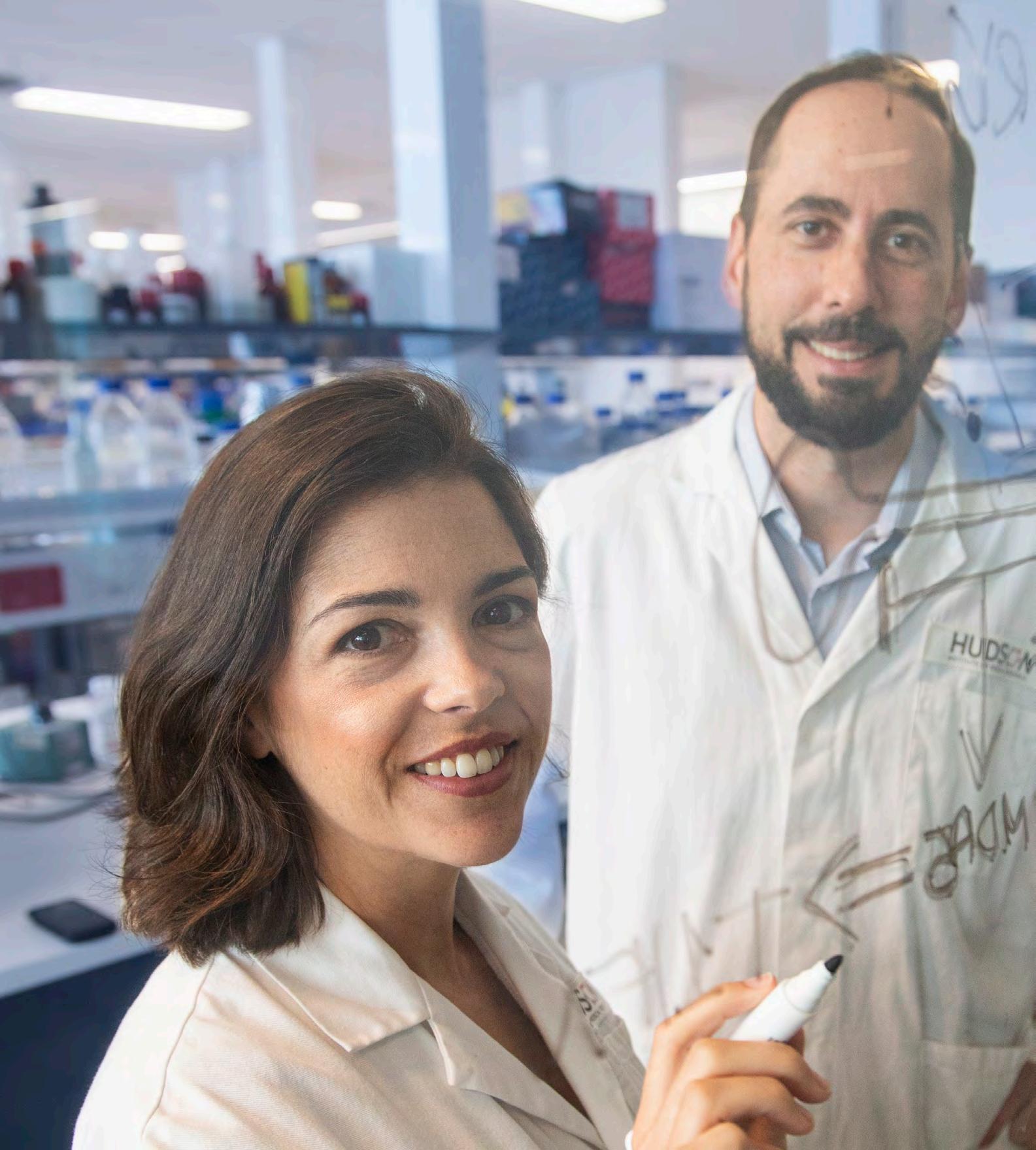
“If we want to employ mRNA therapies to many other diseases, like cancer or gene therapy, we need to avoid side effects to improve tolerance and safety of these therapies," Dr Sampaio said.
mRNA Victoria also saw the potential in A/Prof Gantier’s work, awarding him $200,000 to advance his work on short anti-inflammatory synthetic RNAs (also known as oligonucleotides). The short oligonucleotide fragments (SofraTM) at the basis of this novel technology are being developed in partnership with Pharmorage Pty Ltd and could help devise the next generation of mRNA vaccines.
“RNA technology is changing the face of modern medicine, largely due to the speed at which new treatments, like COVID-19 vaccines, can be developed and rolled out. We’ve only scratched the surface of the potential applications of RNA therapies.”
“RNA therapeutics is the technology of the decade,” said A/Prof Gantier. “It will generate jobs, with leaders such as BioNTech and Moderna now in Melbourne, but it also opens the opportunity to treat many diseases deemed incurable to date.”
DNA and RNA are a class of molecules called nucleic acids (the ‘NA’ in DNA and RNA). DNA contains the genetic information that controls which cells do what in our bodies and RNA converts that genetic blueprint into proteins.
Vaccines aside, RNA therapeutics are already approved to treat a growing number of diseases; for example, a twice-yearly injection for people with high cholesterol to control their condition.
It was this potential, and recognised leadership in RNA research, that saw Dr Sampaio awarded a $690,000 mRNA Victoria Activation Program Grant to better understand how the immune system detects RNA.
An additional $1.5 million from the NHMRC and $700,000 from the Victorian Government will extend this technology to cover autoimmunity and treatments for infection-driven hyperinflammation, such as severe COVID-19 and influenza A infection.
2022 was about more than potential, as A/Prof Gantier was celebrated for his role in an international team that found a genetic cause of the chronic inflammatory disease lupus, driven by the aberrant detection of RNA, with the results published in Nature.
As for the future, RNA holds promise for sufferers of a wide range of conditions, from lupus, inflammatory bowel disease and diabetes to psoriasis.
There is also the potential of mRNA vaccines that are cheaper to produce and carry fewer side effects.
The future for RNA technologies is bright at Hudson Institute.
Collaborators Australian National University; Pharmorage Pty Ltd; St Vincent’s Institute; University of Melbourne; University of New South Wales; University of Technology Sydney; University of Oxford (UK)
Funders DJPR; mRNA Victoria; NHMRC
INFLAMMATION
Associate Professor Michael Gantier
ANNUAL REPORT 2022 23 22 HUDSON INSTITUTE OF MEDICAL RESEARCH
L-R: Dr Natália Sampaio, Associate Professor Michael Gantier
Making a big difference for tiny babies
In business it’s called vertical integration – when the same organisation controls multiple stages of the production process. The medical research equivalent of vertical integration is rare – which is why Hudson Institute is fortunate to have husbandand-wife team Professors Claudia and Marcel Nold, who are engaged in a hugely beneficial working partnership.
“The word ‘research’ is made up of re (meaning ‘again’) and search, so you search, search again and again.
Marcel explains their discovery, published in Science Translational Medicine: “Type-2polarised inflammation drives cardiopulmonary disease in these babies, allowing us to now work on ways to control inflammation in preterm babies and avoid the damage it wreaks.”
The exciting moment is when we find what we were looking for, or something unexpected that now makes total biological sense.”
Professor Claudia Nold
Their combined skills are bringing new treatments for preterm babies, from laboratory discovery to clinical trials in Monash Children’s Hospital’s Neonatal Intensive Care Unit (NICU).
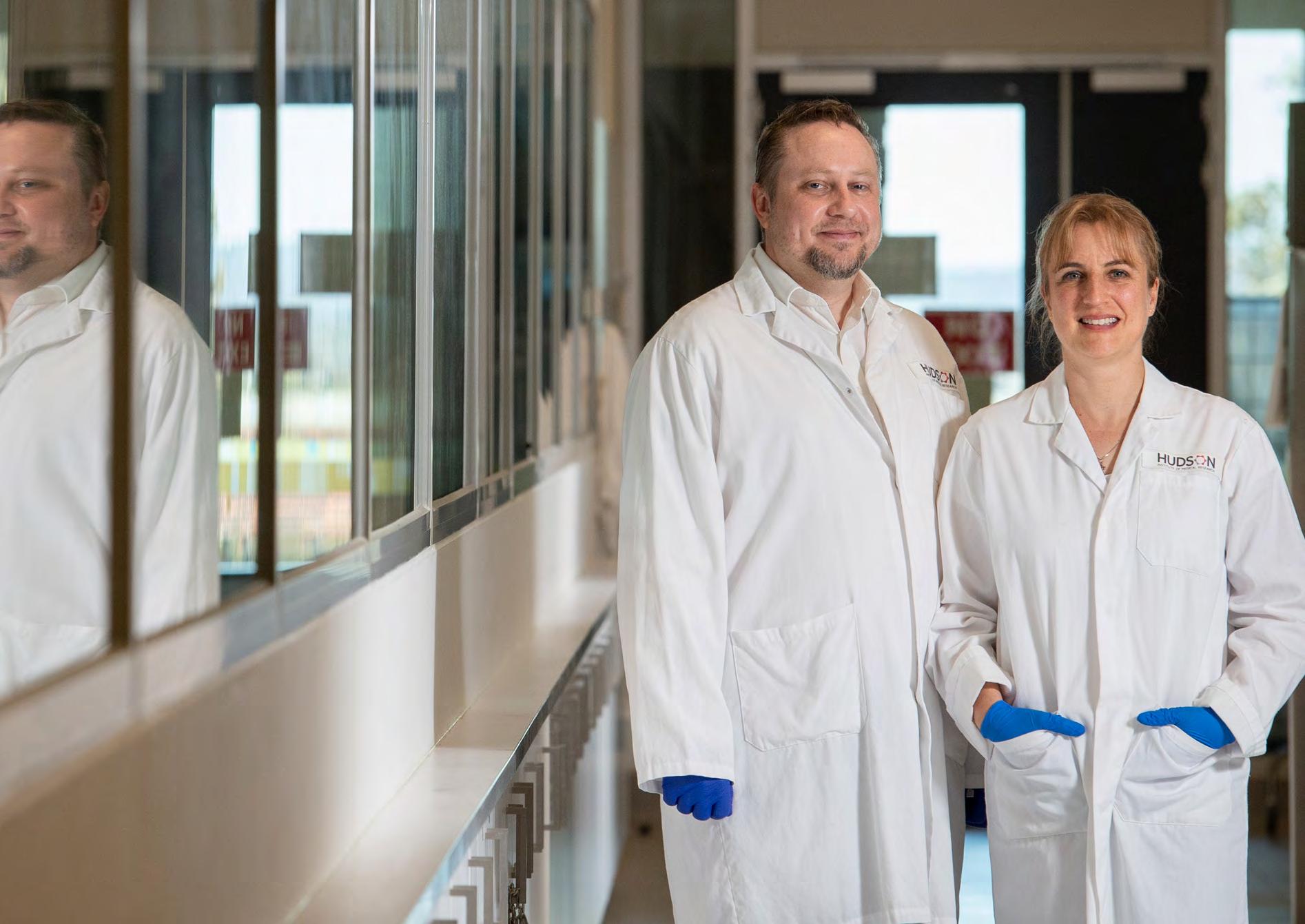
With a background in pharmacology, Claudia spends her time searching for new ways to safeguard the health of tiny infants – aiming to prevent bronchopulmonary dysplasia (BPD), necrotising enterocolitis, and other illnesses, as well as collaborating on prevention of cerebral palsy. She jointly heads the Interventional Immunology in Early Life Diseases Research group.
Meanwhile Marcel, a clinician-scientist, splits his time between the lab and Monash Children’s Hospital, where he’s hands-on with babies like Max (see page 27) and their families during their early difficult days.
These pioneering collaborators are now close to achieving something once thought impossible. Based on decades of work, they are within reach of a treatment to control inflammation in preterm babies that can cause devastating heart, lung, gut and brain conditions.
A remarkable year
In 2022, they identified the specific inflammatory responses that drive illnesses of prematurity and revealed several risk factors both before and after birth.
“It’s one of those ‘eureka’ moments,” says Claudia.
“Like when we discovered the anti-inflammatory function of one of the molecules we were investigating, which we now are developing into a drug.”
They also further advanced their clinical trial of the anti-inflammatory drug anakinra, and they are cautiously positive about the results.
Collaborators 13 University of Technology; Australian Synchrotron, Centenary Institute; CSL Limited, Hunter Medical Research Institute; Mater Research Institute; Mercy Hospital for Women; Monash Children’s Hospital; Monash University; Murdoch Children’s Research Institute; Royal Women’s Hospital; University of Adelaide; University of Melbourne; Victorian Heart Institute; Helios HSK, Germany; National Cerebral and Cardiovascular Center Research Institute, Japan; St. Vincent’s Hospital, Germany
Funders Australian Synchrotron; CSL Ltd; Jack Brockhoff Foundation; National Heart Foundation; NHMRC; Rebecca L Cooper Foundation
NEWBORN HEALTH
Published in Science Translational Medicine, April 2022
ANNUAL REPORT 2022 25 24 HUDSON INSTITUTE OF MEDICAL RESEARCH
L-R: Professors Marcel Nold and Claudia Nold
MAX AND SUSANA
A little over 27 weeks into her second pregnancy, all in the space of a couple of days, Susana went from planning months ahead for her baby’s arrival to giving birth and becoming part of medical history.

Baby Max arrived small and vulnerable, so when doctors in Monash Children's Hospital's neonatal unit asked if she would like her newborn son to be the first participant in a trial of a new treatment to keep preterm babies healthy, she quickly said “yes”.
The drug anakinra has been used to prevent dangerous inflammation for
decades, but never in preterm newborns until this trial.
“We were aware of the dangers to vital organs such as lungs, heart, gut and brain for a baby born so early – it was daunting but I’m proud that we took part. We’ve brought some good to the world,” Susana said.
Now, 10 months on, Max is making good progress and recently even had his first overseas trip – to meet his grandparents for the first time.
But even before he got on the plane, little Max had travelled a long way.
Susana and baby Max
NEWBORN HEALTH 26 HUDSON INSTITUTE OF MEDICAL RESEARCH ANNUAL REPORT 2022 27
28 HUDSON INSTITUTE OF MEDICAL RESEARCH ANNUAL REPORT 2022 29
Collaborating to conquer childhood cancer
• Cancer is the leading disease-related cause of death among Australian children.
• One in five children diagnosed with cancer will not survive.
• For those who do, the majority will suffer long-term disability from the toxic treatments.
• Despite decades of research, survival rates from some cancers have hardly improved.
When it comes to treating disease, the medical profession is increasingly recognising that children are not just small adults: their bodies behave differently.

Sadly, paediatric oncologists are often faced with little option but to treat childhood cancers with repurposed drugs developed for adult cancers. These treatments are frequently ineffective and toxic.
Victorian Paediatric Cancer Consortium
Developing new treatments and cures for children’s cancers is the driving factor behind the creation of the groundbreaking Victorian Paediatric Cancer Consortium (VPCC).

Co-led by Professor Ron Firestein (Hudson Institute) and Professor David Eisenstat (RCH/MCRI), the VPCC brings
VPCC partners
• Hudson Institute of Medical Research
• Monash Children’s Hospital
• Monash University
• Royal Children’s Hospital (RCH)
• Murdoch Children’s Research Institute (MCRI)
• University of Melbourne
• Peter MacCallum Cancer Centre
• Walter and Eliza Hall Institute of Medical Research (WEHI)
• The Children’s Cancer Foundation (CCF)
together a consortium of Victoria’s finest paediatric cancer clinicians and researchers.
With the guidance and generosity of the Children’s Cancer Foundation, and $9.6 million from the Federal Government’s Medical Research Future Fund (MRFF), the VPCC is the result of five years of planning, building global scientific and clinical networks, and lobbying.
In October 2022, the Victorian government pledged $35 million towards the next phase of the VPCC, with the Children’s Cancer Foundation contributing another $10 million. This will benefit a wide range of services including discovery research and clinical innovation programs, integrated biobanking, data management and bioinformatics platforms, and training the next generation of researchers and clinicians.
It also enables the creation of a statewide, multidisciplinary, and collaborative approach to combating childhood cancers, fostering research excellence, innovation, and best-practice clinical care.
The VPCC’s core aims are to
• Develop and advance new and more precise treatments for children.
• Accelerate the participation of children in clinical trials.
• Improve survivorship and long-term health.
• Leverage the diverse expertise of Victorian researchers and clinicians to catalyse the translation of research from bench to bedside.
501 days of chemotherapy
Even after watching her infant son go through such an ordeal, Nelly sees the bright side.
“It’s been a big journey, but the best part is that he doesn’t remember it,” she said.
Eli was just 16 months old when he went from being a happy, healthy boy to beginning chemo in the space of a week. Discomfort on Monday, a trip to emergency on Thursday after discovering a lump, and by Sunday he’d been diagnosed and booked in to start treatment the following day.
“When they were doing the ultrasound I had this terrible sense of dread, but you never expect to hear someone tell you your child has cancer,” Nelly said.
Eli had an embryonal rhabdomyosarcoma (soft tissue cancer) in his bladder, and the treatment was harrowing, but three-and-ahalf years later he remains cancer-free, with plenty of life ahead of him.
Despite so much medical intervention, his development is now back where it should be, with few signs of the ordeal he went through except for the regular six-monthly checks.
Nelly knows who to thank for it: “Medical professionals – scientists like Ron and Jason – they’re all just superheroes in my eyes. It’s so personal for me, so if my story and our journey can help spread the word and attract extra funding, I will work my hardest and scream ‘more funding, please’.”
L-R: Nelly and Eli
ELI AND NELLY CHILDHOOD CANCER
Childhood cancer facts
L-R: Ms Naama Neeman (Hudson Institute), Professor Ron Firestein (Hudson Institute), Jeff Darmanin (CCF), Professor David Eisenstat (RCH/MCRI)
Risk Stratification - Sarcoma program
It’s not just the number of children who succumb to cancer that drives Dr Jason Cain to pursue his research; it’s also the ones who survive.
“Childhood cancer is a devastating diagnosis for the patient and family,” Dr Cain said.
molecular signatures that predict a child’s response to therapy, their risk of metastasis and their potential survival outcomes.
His goal is to determine which patients are likely to respond to which therapies, so ineffective treatments and their side effects can be avoided.
“Many survivors of childhood cancer are left with debilitating long-term side effects of their treatments. We need to do better.”
Dr Jason Cain
“The current treatments for childhood cancer (surgery, chemotherapy and radiotherapy) have remained unchanged for decades. Not all children respond to these therapies, and even those who do are often left with permanent side effects.”
It is those facts that spur him on to understand what causes childhood cancers, then convert that knowledge into a targeted search for new treatments – not just to improve survival rates but also the patient’s quality of life.
Dr Cain leads the VPCC Risk Stratification – Sarcoma program, focused on finding
“No one treatment is going to be effective for all patients, even with the same cancer diagnosis,” he said.
“There is a need to identify several different therapies that can be used in combination to treat patients.”
Now, thanks to the VPCC, the best minds in Victoria’s medical research community have a new platform through which to share and benefit from each other’s knowledge.
“Our findings will enable other researchers in the childhood cancer community to accelerate their own research and discoveries,” Dr Cain said.
Smarter cancer treatments Targeted childhood cancer treatments
Next Generation Precision Medicine program Rarity is a virtue in some fields. Unfortunately, that’s anything but true when it comes to childhood cancers.
Not only are they often uneconomic for drug companies to pour research dollars into, but tissue samples can be hard to come by.
As Head of the Centre for Cancer Research, Professor Ron Firestein wants to change all that with the VPCC Next Generation Precision Medicine program.
The aim is to significantly improve treatment for childhood cancer patients with the greatest unmet clinical need –those diagnosed with brain cancers and solid tumours.
Prof Firestein’s four-pronged approach to the problem includes going beyond
genomic sequencing to what’s called multi-omics, which studies the genome, transcriptome, epigenome and proteome of cancer cells.
Another crucial aspect of this program is the creation of the Childhood Cancer Model Atlas (CCMA) – a tissue bank where samples of actual cancers can be stored and reproduced, to be analysed and tested against potential therapies.
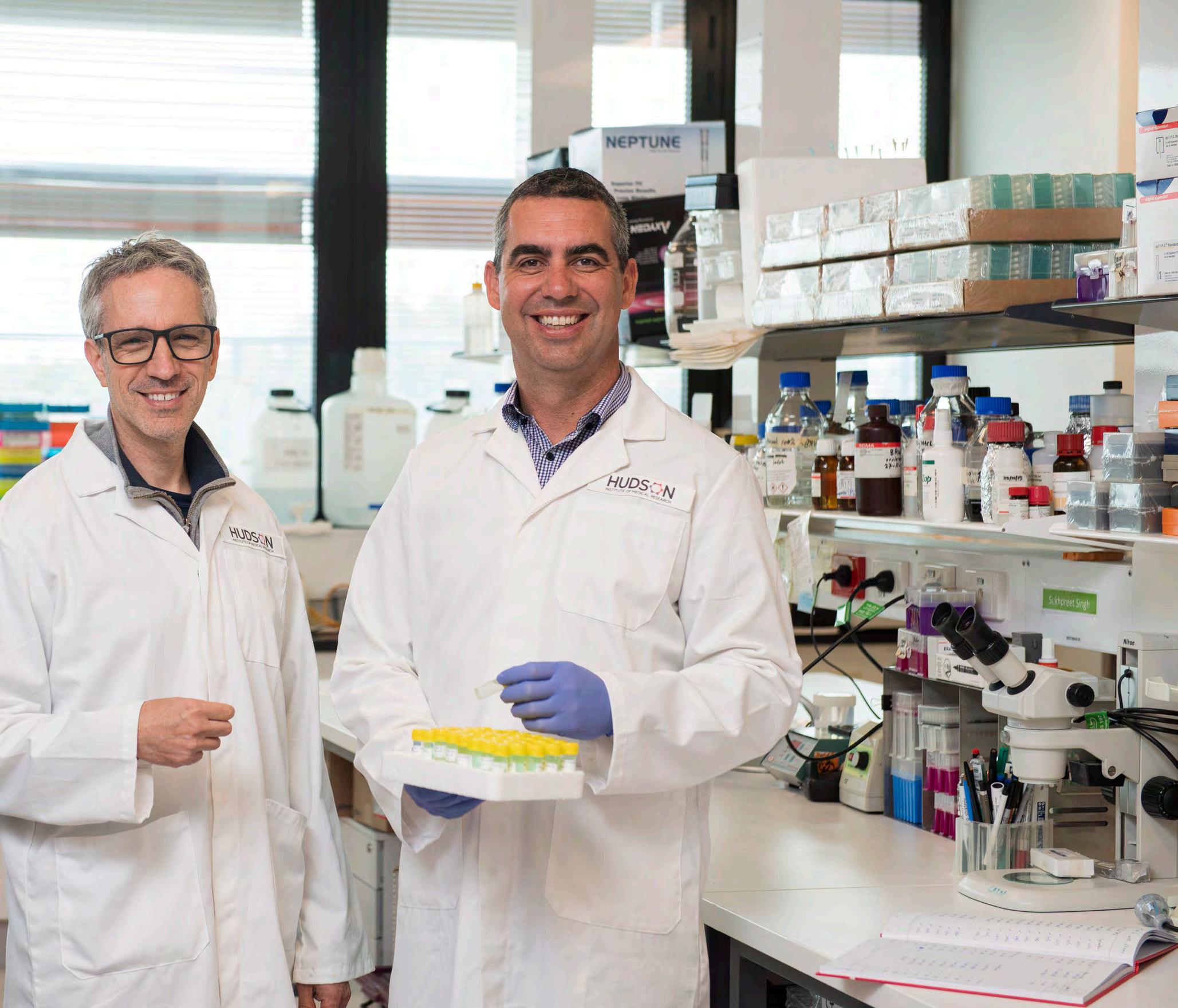
The CCMA is also the largest collection of high-risk paediatric solid tumour cell lines in the world, and for Prof Firestein and cancer researchers everywhere, it is a goldmine.
The CCMA also includes a searchable data portal to foster the collaborative and hypothesis-driven research needed to catalyse clinical translation.
CHILDHOOD CANCER
30 HUDSON INSTITUTE OF MEDICAL RESEARCH ANNUAL REPORT 2022 31
L-R: Professor Ron Firestein, Dr Jason Cain
New leadership at The Ritchie Centre
Leadership can take many forms. Some lead by their actions and the example they set; others by creating new and better ways of doing things. The most successful are those whose leadership enables those around them to lead.
Professor Suzanne Miller ticks all the boxes while, most importantly, providing hope to parents of our most vulnerable babies.
She established her credentials over many years as a leading researcher in the field of fetal and neonatal physiology and brain injury, working to prevent and treat the neurodevelopmental disorders that can have lifelong effects.
her groundbreaking work on targeted neuroprotective treatments for fetal and neonatal brain injury. Further confirmation of her talents came when she was appointed to lead The Ritchie Centre.
It is in this role where she is using her experience to guide and mentor the medical research pioneers of the future.
“The developing brain is fascinating. The fetal brain is exquisitely sensitive to the inutero environment. We are still learning how compromise during pregnancy affects the baby’s brain development and long-term neurological outcomes.”
Professor Suzanne Miller
One of her projects has now progressed to the world-first PROTECT Me Trial, using melatonin to combat the effects of fetal growth restriction (FGR) – a major cause of cardiovascular disease, lung and brain injury in the newborn, as well as contributing to the ongoing development of cerebral palsy, autism, learning and other behavioural dysfunctions.
In 2022, Prof Miller added an NHMRC Investigator Grant to her impressive list of achievements – receiving more than $2.3 million over five years to continue

“I have been lucky to work both directly and indirectly with really clever and enthusiastic researchers and clinicians who have provided mentoring and research guidance,” she said.
“I hope that can now pass on some of what I have learned to provide mentorship and support to the next generation of researchers.
“At the end of my research career, I would be really chuffed if I could say there are fewer children with cerebral palsy or learning disabilities because of new preventions and treatments my team has developed for neonatal brain injury.”
Collaborators Monash Health; Monash University
Funders Cerebral Palsy Alliance; Inner Wheel Australia; NHMRC
NEWBORN HEALTH
“Leadership and learning are indispensable to each other.”
— John F. Kennedy
ANNUAL REPORT 2022 33 32 HUDSON INSTITUTE OF MEDICAL RESEARCH
Professor Suzanne Miller
RONICK
When doctors told Hannah after her 28-week scan that her baby’s growth was well behind schedule, she was understandably concerned – especially in light of previous miscarriages.
So when staff at her obstetric check-up asked if she would like to take part in the PROTECT Me Trial, she and husband Nav did not hesitate.
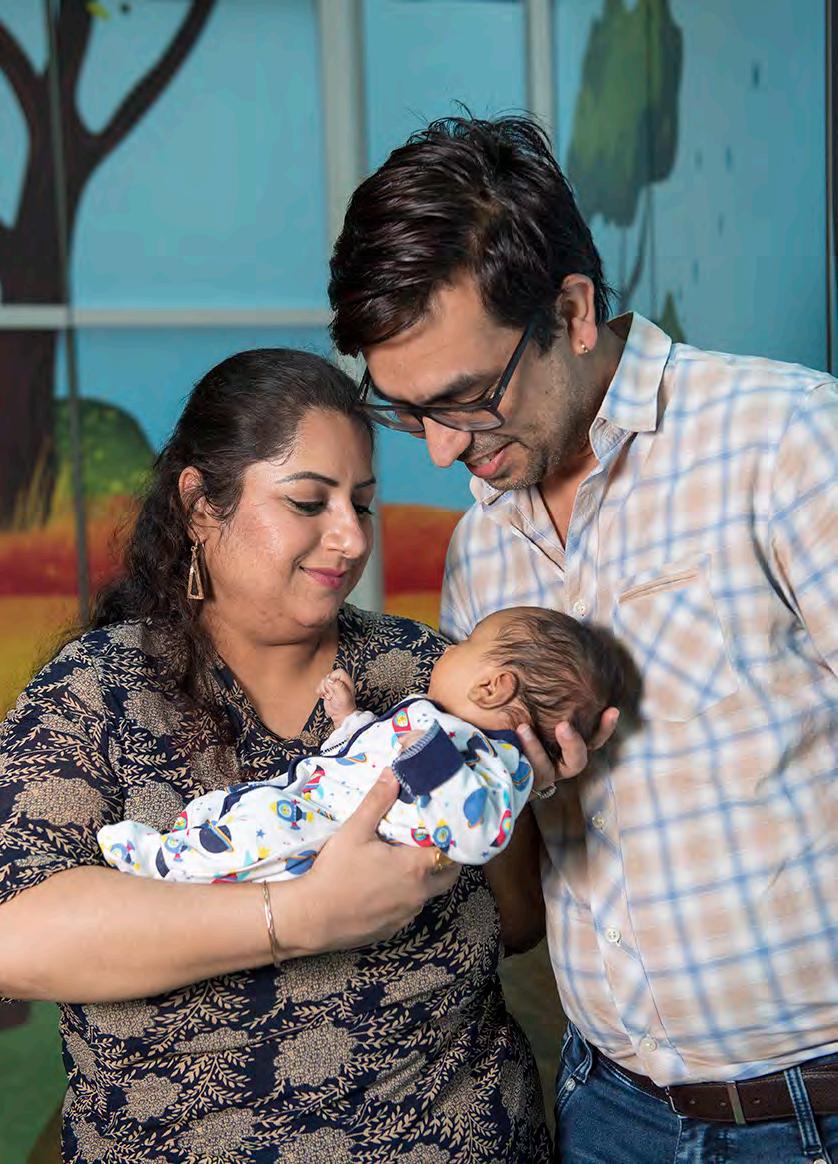
“I believe in science. I trust the doctors and midwives, so I decided to join the trial as soon as I knew there was an issue with my baby’s growth,” she said.
Every week, she returned for a scan with an instruction to “pack your bags because you may need an emergency C-section at any time”.
Baby Ronick waited another seven weeks to come into the world. He weighed 1.88kg (small, but still much more than expected) and gave a good healthy cry when he arrived.
“We were so relieved to have a healthy baby!” Hannah said.
Ronick's progress will be monitored, like the other 335 babies in the trial, and once they have reached their second birthday, the effectiveness of melatonin treatment will be assessed.
Hannah and Nav are proud to have played their part in advancing medical science.
NEWBORN HEALTH
ANNUAL REPORT 2022 35 34 HUDSON INSTITUTE OF MEDICAL RESEARCH
L-R: Hannah, Nav and baby Ronick
Flicking the off-switch for pancreatitis
Pancreatitis is a serious inflammatory gastrointestinal disorder and the starting point for many health problems – up to 20 per cent of patients go on to experience multiple organ failure.
Dr Mohamed Saad and his mentor, Professor Brendan Jenkins, identified a key enzyme called ADAM17, which acts as a central molecular switch leading to pancreatic inflammation – giving them a starting point for the development of new drugs to potentially treat pancreatitis.

Collaborators Monash Health; Monash University; Christian-Albrechts-University (Germany); Weizmann Institute of Science (Israel)
Funders Cancer Council Victoria; NHMRC

Restoring parenthood potential
The after-effects of cancer treatment can have numerous outcomes. In many men, chemotherapy kills the cancer but also damages fertility; however, those men now have new hope thanks to the work of Associate Professor Robin Hobbs. As Head of the Germline Stem Cell Biology Research group, he studies the systems responsible for fertility and the factors that promote cellular regeneration after they sustain damage. His research, published in Nature Communications, provides new understanding of these factors. It could ultimately allow researchers to design ways to help restore fertility of male cancer patients, representing an important step in addressing this major quality of life issue for cancer survivors.
Collaborators Monash University; University of Melbourne; Chinese University of Hong Kong (China)
Funder NHMRC
cure in itself, our new understanding of these pathways may allow us to develop treatments that restore male fertility after chemotherapy.”
Associate Professor Robin Hobbs

Diagnosing curable hypertension
Associate Professor Jun Yang and her team are changing the way GPs think about hypertension (high blood pressure), and saving lives in the process. Her research established that in one in 10 cases, hypertension is caused by a hormonal condition called primary aldosteronism (PA), which means standard treatments are ineffective. The next step was a pilot project encouraging GPs to screen for PA, with results showing far more affected patients than expected. Head of the Endocrine Hypertension Research group and Consultant Endocrinologist at Monash Health, A/Prof Yang has been awarded two large MRFF grants, including a clinical trials grant of $2.29 million over four years to roll out a
screening program in GP clinics, with collaborators in Victoria, South Australia and Tasmania. Further research also identified that existing testing methods for PA need careful analysis – and sometimes even multiple tests – to be accurate. She is now educating clinics and hospitals about PA and helping prepare them for the expected increase in diagnoses of this previously underreported condition.
Collaborators Baker Heart and Diabetes Institute ; Barwon Health; Monash University; University of Queensland; University of Western Australia
Funders Heart Foundation; NHMRC; Rebecca Cooper Foundation
Associate Professor Jun Yang
“Once GPs started to actively screen for PA, the number of hypertensive patients diagnosed with PA jumped from one in 1000, to 140 in 1000.”
“Our research is the first to give hope that we have found a key to new, effective treatments for this condition."
Dr Mohamed Saad
“While it’s not a
Published in Medical Journal of Australia, March 2022
L-R: David Wyatt, Associate Professor Jun Yang
Published in Proceedings of the National Academy of Sciences, October 2022 Published in Nature Communications, May 2022
L-R: Dr Mohamed Saad, Professor Brendan Jenkins
ANNUAL REPORT 2022 37 36 HUDSON INSTITUTE OF MEDICAL RESEARCH
Associate Professor Robin Hobbs
Gastroenteritis breakthrough
Ending preventable stillbirths
Stillbirth is devastating for any family, and Dr Miranda Davies-Tuck is working to better understand why it happens. A 2022 study by Dr Davies-Tuck’s team published in The Australian and New Zealand Journal of Obstetrics and Gynecology, March 2022, looked at all births in Victoria between 2010 and 2018, finding that full-term stillbirth rates have reduced, but the overall stillbirth rate has remained at approximately six babies per day. That means preterm deaths are on the rise. This strengthens her focus on research to reduce pre-term stillbirths. After previously establishing that women of South Asian origin (India, Pakistan, Bangladesh and Sri Lanka) have a higher risk of stillbirth in late pregnancy, she recommended more fetal monitoring for this group. Those clinical changes have now been incorporated into clinical guidelines nationally. In 2022, the team took this research further by talking to those mothers – many of whom do not have English as their native language –about their experience of these clinical changes. The findings showed that better communication is just as important as better monitoring in making sure both mother and baby have a positive birth experience.

Collaborators Monash Health; Monash University Funder Red Nose Australia
“This is the first time the voices of South Asian women have been captured in regard to stillbirth prevention strategies.”
Dr Miranda Davies-Tuck
How emphysema wreaks havoc
Dr Cristina Giogha studies a range of medically important bacteria that cause millions of deaths worldwide every year due to gastroenteritis, such as E. coli, Salmonella and Shigella. It is well known that E. coli destroy intestinal structures called microvilli – tiny fingerlike projections on intestinal cells that are vital for absorbing nutrients and water from the gut – but until now there has been little understanding of the mechanics of how this occurs. 2022 brought a breakthrough, with Dr Giogha and her mentor, Professor Elizabeth Hartland, showing for the first time

the involvement of specific human and bacterial factors in the destruction of microvilli. She sums up her findings simply: “If the cell is like your home, E. coli are like unwanted guests that remodel your home to suit themselves.”
Collaborators University of Melbourne; University of Saskatchewan (Canada); Vanderbilt University (USA)
Funders Australian Research Council; NHMRC; China Scholarship Council (China); National Institutes of Health (USA); Vanderbilt University (USA)
“Our work aims to understand the mechanisms by which E. coli bacteria cause gastroenteritis, so new treatments can be designed, potentially saving thousands of lives, particularly in low-income countries.”
Dr Cristina Giogha
Emphysema is the major debilitating lung disease associated with inflammation caused by uncontrolled activation of the immune system. The two arms of that system are innate immunity, or the first line of defence against invaders, and immune system adaptive immunity, which mounts a slower, highly specific immune response. The triggers that promote the development of emphysema have been elusive, preventing advances in patient treatments. In a pivotal breakthrough, a team led by Professor Brendan Jenkins discovered that a regulatory complex of the innate immune system, called inflammasomes, is responsible for the development of emphysema. This world-first finding lays the foundation for new emphysema treatments targeting the immune system.
Collaborators Monash Health; RMIT University; University of Melbourne; Christian-Albrechts-University (Germany); National Cancer Institute (USA)
Funder NHMRC
“It is significant research, because it’s the first to demonstrate a specific pathological role for inflammasomes in emphysema that is separate from their immune activity.”
Professor Brendan Jenkins

Published in Women and Birth: Journal of the Australian College of Midwives, July 2022 Published in Procedures of the National Academy of Sciences, August 2022
Dr Miranda Davies-Tuck
Professor Brendan Jenkins
Published in Proceedings of the National Academy of Sciences, June 2022
38 HUDSON INSTITUTE OF MEDICAL RESEARCH ANNUAL REPORT 2022 39
Dr Cristina Giogha
Solving the gut health puzzle
Business development and commercialisation
Business development and commercialisation ensures the Institute’s scientific discoveries move from the laboratory to patients’ bedsides. Working with industry, academic and government partners, research is protected, commercialised, and developed for future use. Partnerships are forged with pharmaceutical, clinical and venture capital organisations to progress research from early stages to clinical trials, and ultimately to patients’ treatments or diagnosis.
The value of commercial agreements continues to be an important category of the Institute’s total revenue – over the last three years, we have attracted over $15.8 million, with exceptional prospects for growth in 2023.
Nine patents protecting scientific discoveries were granted in a range of countries, while six provisional patent applications were progressed to PCT or International Phase, and two new provisional applications were filed. Significant commercial transactions included
the commercial use of RNA technologies.
• The creation of a biotech start-up that focuses on the development of tests for the diagnosis and monitoring of cancer.
• The licencing of microbiomerelated IP from the Microbiota and System Biology Research group to Biomebank, a clinical-stage biotechnology company.
• The establishment of a spinout company to develop a novel anti-cancer strategy.
increase in finalised contracts and commercial agreements on the previous year.
Successful commercially targeted or translational grants included
• Victorian Medical Research Acceleration Fund ($0.2 million)
• mRNA Victoria Activation Program ($0.7 million)
• National Health and Medical Research Council Development Grant ($0.9 million)
The cells that line the intestines are a crucial interface between the outside world and the human body, but many mysteries remain as to how they work. Research published by an international team led by Hudson Institute investigated so-called Mediator kinases – regulators of gene expression – and discovered that they play an unexpected role in maintaining a proper balance of the different cell populations that make up the intestinal lining. Dr Marius Dannappel and Dr Danxi Zhu, with their mentor Professor Ron Firestein, found
that Mediator kinases also interact with another group of proteins that have been linked to many diseases and cancers. Their findings have wideranging implications for inflammatory conditions affecting the intestine, such as Inflammatory Bowel Disease (IBD) and cancer.
Collaborators Monash Health; Monash University; University of Texas (USA)
Funders NHMRC; China Scholarship Council (China); DFG, German Research Foundation (Germany)
“We discovered that Mediator kinases play a pivotal role in orchestrating the production of the cells lining the intestinal lumen, particularly for specialised cell types (Paneth cells, tuft cells and goblet cells) responsible for organising the defence against infection.”
Dr Danxi Zhu
• A partnership with Pharmorage’s Noxopharm (ASX:NOX), a clinical-stage drug development company that has been established to focus on drug discovery and
Hudson Institute was also actively involved in the start-up of two other companies and two new IP licences that were established for further start-up initiatives. In addition, the Institute successfully achieved an overall 10 per cent
• Department of Jobs, Precincts and Regions COVID funding ($1.5 million)
• Two grants from CUREatorAustralia's national biotech incubator (totalling $5.5 million).


Published in the Journal of Clinical Investigation, October 2022
L-R: Dr Marius Dannappel, Professor Ron Firestein, Dr Danxi Zhu
ANNUAL REPORT 2022 41 40 HUDSON INSTITUTE OF MEDICAL RESEARCH
Thank you to our supporters
We are grateful for the gifts received from individuals, trusts, foundations and organisations during the year. We also acknowledge the support of the Victorian State Government and the Australian Government.
Funding bodies
Andrea Joy Logan Trust
Australian Communities Foundation
Australian Government, Medical Research Future Fund
Australian Research Council
Bethlehem Griffiths Research Foundation
Can Too Foundation
Cancer Australia
Cancer Council Victoria
Canteen
Carrie's Beanies for Brain Cancer
CASS Foundation
Cerebral Palsy Alliance
Children's Cancer Foundation (CCF)
Children’s Tumour Foundation
Cure Brain Cancer Foundation
Department of Defense (USA)
Eva and Les Erdi Charitable Foundation
Financial Markets Foundation
Inner Wheel Foundation
Isabella and Marcus Foundation
Johnson & Johnson
Leukaemia Foundation
Magee-Womens Research Institute and Foundation
Minderoo Foundation
National Health and Medical Research Council
National Heart Foundation
National Institutes of Health (USA)
Norman Beischer Medical Research Foundation
Ovarian Cancer Research Foundation
Robert Conner Dawes Foundation
Royal Australian College of Physicians
RUN DIPG
Snowdome Foundation
Stillbirth Foundation Australia
The Kids' Cancer Project
University of Birmingham (in partnership with CCF)
Victorian Cancer Agency
Victorian Government, Department of Jobs, Precincts and Regions
Victorian Government, Operational Infrastructure Support Scheme
You Are My Sunshine Foundation (YAMS)
Zero Childhood Cancer Program
Major donors
The Evans Family Foundation
Professor Kate Loveland
Estate of Robert Dale Checcucci
Australian Communities Foundation
Mrs Ann Lorden
The Piers K Fowler Scholarship Fund
Invetech
Mrs Jill M Ross-Perrier
Ms Sally Maconochie
Lord Mayor's Charitable Foundation
Associate Professor John McBain AO
Professor Lois Salamonsen
Professor Caroline Gargett
Dr Fiona Clay
Fire Rescue Victoria
Lifestyle Communities Officer
The Hon. Gayle Tierney
Mr Claude Lombard OAM
Mr Joseph Zouki
Dr Robert Edgar AM
Mr Neville Marriott
Mrs Kathleen Johnston
Mrs Regine Lindner
Mrs Jill D'Arcy
The Phoebe Jones and Jacob Jones Trust
Bensons Property Group
Mrs Ella Matheson
Mr Luke and Mrs Susi Lindner
Mrs Joan Donaldson
Dr Miriam Shalit and Mr Greg Faine
Professor Arthur Clark
S&D Hain Foundation
Mr Alfred Frohlich
Give and take – one family’s cancer journey
By any measure, cancer has played too large a role in Ann Lorden’s life. Both she and her daughter have fought breast cancer and won, but her husband Max sadly lost his fight with renal cancer in 2017. However, it was when her granddaughter Ella faced her own cancer challenge at just eight years old that Ann decided to do whatever she could to make a difference.
Ella is now a healthy 15-year-old, looking forward to her upcoming student exchange trip to Japan. But seven years ago, things looked very different when she was diagnosed with osteosarcoma –a type of cancer that begins in the cells that form bones.
“From my experience as a nurse in the 1970s to when Ella had her treatment, the drugs were the same,” says Ann.
The oncologist noted that there was no money for commercial companies in developing treatments for rare cancers, so that has driven her own personal philanthropy to Hudson Institute.
Dr Jason Cain’s lab will be the main beneficiary of this generous funding and he says it’s an area of great need in cancer research.
“When it comes to rare childhood cancers the pharmaceutical industry rarely invests in treatments and cures, so our role is to fill those gaps,” Dr Cain said.
“With our Childhood Cancer Model Atlas (CCMA), Hudson Institute is now home to the world’s biggest bank of paediatric tumour tissue samples, giving researchers everywhere the opportunity to run tests to establish which cancers are likely to respond best to which treatments.”

Ann made her first donation in 2018, in her late husband’s name. Five years on she is donating again, proud that her funding will help to build a brighter future for kids like Ella, who find themselves facing the fight of their lives. Her generous philanthropy will continue to allow for expedited and innovative research into osteosarcoma, in areas such as more precise diagnostics and new therapy projects.
“My children and grandchildren could have a lovely holiday with their inheritance after I’m gone, but there’s more good to be done for kids just like Ella by giving while living.”
Ann Lorden
L-R: Dr Jason Cain, Ella, Ann Lorden
PHILANTHROPY ANNUAL REPORT 2022 43 42 HUDSON INSTITUTE OF MEDICAL RESEARCH
Our loyal supporters
Hudson Institute is grateful for the ongoing support of our generous trusts and foundations who form part of our wider community, helping to connect our Institute and scientists with patients who inform our research.
Children’s Cancer Foundation
Hudson Institute is deeply appreciative of its partnership with the Children's Cancer Foundation (CCF). As featured earlier in this Annual Report, the Children's Cancer Foundation played a critical role in helping launch the Victorian Paediatric Cancer Consortium (VPCC). This new consortium has allowed Hudson Institute’s childhood cancer research to accelerate like never before. In October, the Children's Cancer Foundation was instrumental in creating yet another catalytic initiative.
Through tireless petitioning, a groundbreaking pledge was made by the Victorian Government to invest $35 million to support childhood cancer research. Additionally, the Children's Cancer Foundation has contributed an additional $10 million, amplifying the collective effort of childhood cancer researchers and ensuring continuity and extension of our life-saving work.
Can Too Foundation
Hudson Institute was honoured to commence a new funding relationship in 2022 with the innovative and inspiring Can Too Foundation. Committed to funding cancer research, Can Too is an independent health promotion charity that believes everyone can achieve goals they once thought impossible. Can Too was specifically drawn to the cancer research being conducted by our early career cancer researchers and has committed to supporting Dr Dongmei Tong, whose cancer research is identifying biomarkers for stomach lymphoma.
Cerebral Palsy Alliance
For more than 70 years, Cerebral Palsy Alliance has been helping anyone living with neurological and physical disabilities to lead the most comfortable, independent and inclusive life possible. One of the ways they provide this support is through strong ongoing commitment to funding high quality research. Research Group Head of Perinatal Cardiovascular Physiology Dr Beth Allison received funding from the Cerebral Palsy Alliance to assist her research into the pregnancy complication, fetal growth restriction (FGR), which affects up to 10 per cent of pregnancies worldwide. With the Cerebral Palsy Alliance’s support, Dr Allison can continue her examination of how babies with FGR can have the best chance of maximising their potential.
Ovarian Cancer Research Foundation
We are proud to continue our longstanding partnership with the Ovarian Cancer Research Foundation (OCRF). With their support, the search for a breakthrough in early detection of ovarian cancer continues. Funding received from OCRF in 2022 continues to support Dr Andrew Stephens’ ovarian cancer research, the OCRF tissue bank at Hudson Institute, and Dr Maree Bilandzic's precision medicine program that directs treatment options. Additionally, new funding from OCRF is supporting Professor Ron Firestein to lead a project investigating ways to disrupt the workings of a protein that increases the ability of cancer cells to grow and metastasize.
Community rallies for Jessica
If it takes a village to raise a child, the same village will often come together to mourn a young person taken too soon.
Throughout their cancer journey, the Lindner family became familiar with the research into rare childhood cancers being undertaken at Hudson Institute, as Jessica’s tumour was biopsied and analysed at Hudson Institute before a customised treatment regime was designed.

After that experience, and the devastation of losing their daughter, they chose to create something positive out of their grief, giving hope to other families who might find themselves in a similar situation.
It is also an excellent tool for training PhD students, medical students and paediatric oncology research fellows in childhood brain cancer research.
“By raising funds in Jessica’s name for this important research, we are hopeful that one day another family won't have to lose a child to a similar disease.”
That was the sad but inspiring story surrounding the death of 13-year-old Jessica Lindner. Diagnosed with a rare form of brain cancer, Jessica fought until the last moments, but eventually succumbed to the disease. It wasn’t the end of her story, though – it actually marked a new beginning.

Susi and Luke Lindner requested that friends, family and colleagues make donations in Jessica’s name instead of gifts or flowers. That decision resulted in nearly $10,000 being raised by the Lindner family’s community. When Luke’s employer Invetech pledged an extra $11,000, they had raised almost $21,000.
That total was enough for Hudson Institute to purchase a digital microscope with computer software that allows us to recognise and analyse cancer cells grown from patients.
The Will to live
Philanthropy: noun
1. The effort or inclination to increase the wellbeing of humankind, as by charitable aid or donations.
2. Love of humankind in general.
The word philanthropist may not sit comfortably with Janine Flatt, but it describes her perfectly. As in so many cases, a tragic bereavement – the death of her husband – was the catalyst for Janine’s decision to donate to medical research. But that’s just a reflection of the spirit that inspired it – the love of humankind in general.
As an African-American US military veteran, Bruce Hall never knew he was in a high-risk group for stomach cancer
“I’m not a millionaire and there are other diseases I could have donated to, but stomach cancer is so much more prevalent than I’d realised, and I know my donation will make a difference.”
Janine Flatt, donor

linked to gastric bacteria (H.pylori) infection. Even when he was diagnosed with H.pylori infection in April 2017, there was no mention of increased cancer risk.
So, no-one expected this fit, nonsmoking teetotaller to succumb to the disease at the age of 64. Piling stress on top of Janine’s grief, Bruce died without a Will, leaving Australian-born Janine alone in the USA, with a lengthy and draining legal process to settle his affairs.
So, when Janine heard about Dr Richard Ferrero’s research at Hudson Institute into precisely this condition, she decided a donation from Bruce’s estate was an effective and appropriate way to help others avoid a similar fate.

Janine is in good company, too –another significant funder of this research is the US government itself.
“I felt so strongly about this link between H.pylori and cancer, and then to find out it’s so prevalent among people just like
The microscope, with a plaque in Jessica’s memory, was unveiled in late 2022 in the Centre for Cancer Research in a touching ceremony attended by the Lindner family.


Now, as well as their cherished memories of a daughter and sister, Jessica’s family have an enduring legacy in her name that they know will bring treatments and cures for rare childhood cancers closer to reality.
Bruce, I wanted to make a difference if could,” Janine said.
“It is good to hear the US Dept of Defense look beyond their immediate shores to fund and utilise the research skills of those at Hudson Institute.”
Now living back in Australia, unsurprisingly, one of the first things Janine asks people is: “Do you have a Will?”
Jessica Lindner
Dr Dongmei Tong
Dr Beth Allison
L-R: Premier Daniel Andrews, The Hon Jaala Pulford, Jeremy Smith (CCF)
Dr Maree Bilandzic
Luke Lindner
Jessica Lindner
TRUSTS AND FOUNDATIONS ANNUAL REPORT 2022 45 44 HUDSON INSTITUTE OF MEDICAL RESEARCH
L-R: Janine Flatt, Bruce Hall
Research excellence
Hudson Institute’s discoveries are supported by competitive, peer-reviewed funding, which underpins our researchers’ salaries and research projects.
Competitive fellowships and grants awarded by the National Health and Medical Research Council (NHMRC), the Medical Research Future Fund (MRFF) and philanthropic and industry funding bodies are selected in a highly competitive process, where expert panels assess and rank applications on scientific merit, innovation and track record.
When a researcher’s grant proposal is successful, it demonstrates how highly they are regarded by their peers. However, the competition for available grants is extremely strong and limited budgets mean only a small percentage of applications receive funding.
NHMRC Investigator Grant





Research area: Fetal growth restriction, newborn health
Associate Professor Michelle Tate



NHMRC Ideas Grant
Research area: Inflammation, influenza
ARC Discovery Grant
Research area: Reproductive health, male fertility and cancer
Associate Professor Samuel Forster
CSL Centenary Fellowship
Research area: Microbiome, IBD, AMR
NHMRC Ideas Grant
Research area: Newborn health, newborn breathing
Associate Professor Michael Gantier



mRNA Victoria Research Acceleration Fund
Victorian Government COVID-19 Treatments Medical Research Fund
NHMRC Ideas Grant
Victorian Cancer Agency Mid-Career Research Fellowship
Research area : Cancer, acute myeloid leukaemia
Associate Professor Jaclyn Pearson
Superstars of STEM
Sylvia and Charles Viertel Charitable Foundation Senior Medical Research Fellowship
Research area: Inflammation, antimicrobial resistance
Professor Brendan Jenkins
US Department of Defense (DoD) Grants
Research area: Inflammation, stomach cancer, pancreatic cancer
mRNA Victoria Activation Program
Grant
Research area: Inflammation, RNA
Associate Professor Rebecca Lim
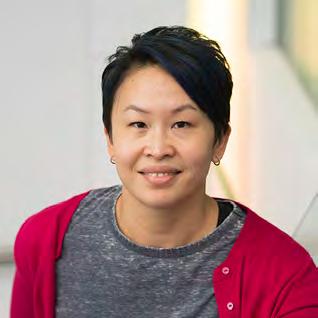
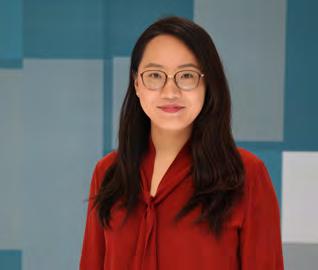
NHMRC Development Grant
Research area: Inflammation, stem cell therapies
NHRMC Ideas Grant
Research area: Reproductive health, endometriosis
Research area: Inflammation, RNA, autoimmune diseases
Dr Claire Sun

Victorian Cancer Agency Early Career Research Fellowship
Research area: Cancer, childhood cancer
Associate Professor Patrick Western
NHMRC Ideas Grant
Research area: Reproductive health, inherited diseases
Professor Suzanne Miller
Dr Catherine Carmichael
Associate Professor Robin Hobbs
Dr Natalia Sampaio
Dr Fiona Cousins
PEOPLE
Dr Kelly Crossley
46 HUDSON INSTITUTE OF MEDICAL RESEARCH ANNUAL REPORT 2022 47
Collaboration generates innovation
Seed Funding Awards
Australia’s health and medical research sector has the potential to be one of the most innovative and commercially successful in the world – employing thousands of people and creating preventative therapies, vaccines and treatments for the betterment of human health.
However, a constrained funding environment means many promising early and mid-career scientists no longer necessarily receive funding for their research, even when it is assessed as ‘outstanding’ by peer review.
Hudson Institute’s Research Committee established the Innovation Seed Awards to provide seed funding to support innovative blue-sky ideas, interdisciplinary research, and collaborations between researchers. This funding allows researchers to gather the baseline data for out-of-the-box ideas – and provides a clear pathway to sustainable funding.
Senior Researcher Award Winners
Dr Beth Allison, Professor Mark Hedger
Project title Finding a new marker for brain injury following birth
Disease impact | Brain injury at birth, cerebral palsy
Associate Professor Simon Chu
Dr Wilson Wong
Project title Utilising powerful imaging technology to uncover drug targets
Disease impact | Ovarian granulosa cell tumours
Dr Robert Galinsky, Professor Richard Ferrero
Project title A new approach to investigating infection-related inflammation in the preterm brain
Disease impact | Preterm brain
Postdoctoral Researcher Award Winners

Associate Professor Jun Yang, Dr Miranda Davies-Tuck
Project title Aldosterone and renin in hypertensive disorders of pregnancy (ALDOHOP study)
Disease impact | Hypertension in pregnancy
Dr Rukmali Wijayarathna, Dr Eveline de Geus
Project title | Could interferon-epsilon protect against viruses affecting male reproduction?
Disease impact Protecting the male reproductive system against viruses, e.g. mumps, Zika virus and herpes simplex virus
Dr Le Ying, Dr Raissa Wibawa
Project title | Establishing a novel stem cell model to study Legionnaires’ disease
Disease impact Legionnaires’ disease, pneumonia
Dr Marius Dannappel, Dr Catherine Carmichael
Project title | Identifying novel regulators of immune cell function and differentiation
Disease impact
Inflammation and cancer
Dr Shanti Gurung, Dr Michelle Chonwerawong
Project title Treating gastrointestinal-graftversus-host-disease with endometrial mesenchymal stem cells
Disease impact Graftversus-host-disease, gastrointestinal tract
AWARDS
COLLABORATIVE
“Seed funding is crucial for starting innovative research projects and collecting critical data needed to secure funding. Importantly, this funding also builds multi-disciplinary teams that bring unique perspectives and resources to challenge the status quo.”
Professor Ron Firestein, co-chair, Research Committee
L-R top: Dr Eveline de Geus, Dr Catherine Carmichael, Dr Michelle Chonwerawong
L-R
bottom: Dr Raissa Wibawa, Dr Rukmali Wijayarthana, Dr Marius Dannappel, Dr Shanti Gurung. Absent : Dr Le Ying
L-R top: Dr Miranda Davies-Tuck, Professor Richard Ferrero, Dr Robert Galinsky, Dr Beth Allison
48 HUDSON INSTITUTE OF MEDICAL RESEARCH ANNUAL REPORT 2022 49
L-R bottom: Dr Wilson Wong, Associate Professor Simon Chu, Professor Mark Hedger, Associate Professor Jun Yang.
Who are we?
Our scientists and students come from all corners of the globe to advance medical science in their various fields. Together, they represent 29 countries and speak 27 languages. Having a rich diversity of knowledge and experience is the lifeblood of scientific discovery. We foster an inclusive and positive culture for all staff regardless of age, race, religion, gender identity, sexual orientation, disability, or spiritual belief.
During the year, the Equity & Diversity and Culture & Engagement Committees organise a broad range of events to celebrate and share our rich diversity. Here are some of the 2022 highlights in our celebration calendar.

International Women's Day: We recognised our team of strong, passionate, intelligent and committed women.
Harmony Day: We celebrated multiculturalism, inclusiveness and belonging.
Pride Month: It was time for our rainbow pins to sparkle and to add a splash of colour in support of LGBTQI+ friends and colleagues.
National Reconciliation Week: With the theme ‘Be Brave. Make Change’, we acknowledged our shared histories, cultures and achievements, and how we all contribute to them.
NAIDOC Week: We celebrated the history, culture and achievements of Aboriginal and Torres Strait Islander peoples. Wellbeing Week: This comprised a week of celebrations –including RUOK? Day – to remind us to take the time to look after our individual and collective wellbeing.
LGBTQI+ STEM Day: This featured the 'LGBTQI+ Morning Tea', with the sharing of rainbow baking treats.
EQUITY AND DIVERSITY 50 HUDSON INSTITUTE OF MEDICAL RESEARCH ANNUAL REPORT 2022 51
Equity and Diversity Committee, from 12 o'clock: Dr Shayanti Mukherjee, Sarah Rosli, Dr Cristina Giogha, Ann Scott, Dr Jason Cain, Dr Beth Allison, Madelene Rich, Dr Christopher Harpur
Scientists in action
During the year, our scientists joined in a range of activities, giving back to the communities that support medical research.
Inspiring young scientists
Hudson Institute's Young Women in Science program provides an intensive oneweek immersive laboratory experience program for 12 local Year 10 high school students.
Evidence shows that having a STEM role model plays a big part of choosing STEM subjects at school and STEM careers.
Frocktober
Art-meets-science education event
Communicating Endo through Art was a community event showcasing works from Australian and French artists living with endometriosis. The evening, attended by the Hon Jaala Pulford, Minister for Innovation, Medical Research and the Digital Economy, provided an open forum for people living with the disease, supporters, scientists and clinicians to discuss leading-edge endometriosis research. Speakers included Professors Caroline Gargett and Elizabeth Hartland, the event’s instigator, Dr Susanne Ilschner, and, from Endometriosis Australia, Directors Maree Davenport and Monica
Ride4Research
Associate Professor Simon Chu cycled 900 kilometres from Canberra to Melbourne for Ride4Research in May, organised by ROC Inc (Rare Ovarian Cancer Incorporated).
A/Prof Simon Chu studies granulosa cell tumours (GCT), with much of his funding coming from ROC Inc. GCT survivor, eight-year-old Neve, who is the youngest person diagnosed with ovarian cancer (aged 11 months), led the cyclists across the finish line.

Ovarian cancer scientists frocked up to support the Ovarian Cancer Research Foundation (OCRF) Frocktober campaign, raising funds and awareness. Our team is working on an effective early detection test and new treatments.
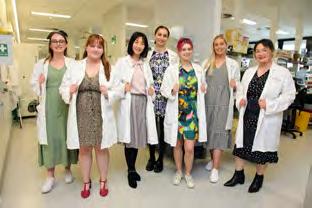
The program gives young women an insight into the science underpinning medical research, with the aim of inspiring a career in science. Each
student is partnered with a leading female scientist for a ‘behind the scenes’ insight into the laboratory science underpinning medical research.
Students spend their time immersed in laboratory life – learning how to formulate and test hypotheses, prepare experiments, draw conclusions and join in lab meetings and group discussions. They also tour the state-of-the-art technology platforms used by our scientists and, on their final day, present work to their group, teachers and family.
“We hope this program gives young women the courage and confidence to
continue their studies in science, leading to a greater representation of women as STEM leaders.” said endometriosis researcher and program convenor, Dr Fiona Cousins.
“Initiatives such as this aim to help young women see the breadth of career opportunities available, as well as connect them with a successful female mentor for advice on how to carve out a career in this industry,” she said.
Young Women in Science was made possible by funds raised by Hudson Institute staff, students, and supporters in this year’s Run Melbourne event.

Koala Kids helps children and families going through cancer treatment. In August, childhood cancer scientists swapped their lab coats for high vis vests, volunteering in the Koala Kids warehouse.

Million Dollar Lunch
The Children's Cancer Foundation's (CCF) fundraiser The Million Dollar Lunch was back in August 2022 after a pandemic hiatus. Cancer scientists were there on the day to help achieve a record tally.


Despite detection taking just minutes, high blood pressure continues to claim the lives of millions each year. To raise awareness during May Measurement Month, Associate Professor Jun Yang set up a monitoring station offering free blood pressure checks to visitors at Monash Medical Centre.

Connor’s Run
Cancer scientists and their families took part in Connor’s Run in September to raise money for the Robert Connor Dawes (RCD) Foundation, which supports paediatric brain cancer research and clinical care.

Run Melbourne
In July, more than 50 scientists, staff and their families donned their runners to raise funds at Run Melbourne in support of our Young Women in STEM program – a twoweek immersive laboratory experience for 12 local female high school students.

While girls and boys perform similarly in STEM subjects at school, at tertiary level only 19 per cent of girls study STEM subjects compared to 42 per cent of boys.
Women make up only 28 per cent of the workplace in Science, Technology, Engineering and Mathematics (or STEM) careers.
Evidence shows that having a STEM role model plays a big part in choosing STEM subjects at school and STEM careers.
Back row: Professor Elizabeth Hartland, Dr Fiona Cousins, Aimee Booth. Second back row: Luvleen Chand, Mohana Lakshminarayanan, Annabelle Lau, Neo Menger Second front row: Grace Groves, Amaal Ibrahim, Mandy Lai, Shazfa Mohamed Shafee. Front row: Ashleigh Puar, Van Lal Diki Khupno, Arushi Tandon
Neve presents the fundraising cheque to Associate Professor Simon Chu
Koala Kids
L-R: Dr Yuqing Liang, Dr Paul Daniel, Shazia Adjumain and Dr Claire Sun
The Hon Jaala Pullford, Minister for Innovation, Medical Research and the Digital Economy, views artwork with Professor Elizabeth Hartland and Dr Susanne Illschner.
L–R: Brittany Doran, Maria Petraki, Dr Yiqian Chen, Teharn Hegarty, Dr Amy Wilson, Dr Laura Moffitt and Trang Tran
Run Melbourne, team Hudson
COMMUNITY 52 HUDSON INSTITUTE OF MEDICAL RESEARCH ANNUAL REPORT 2022 53
L-R: Melissa Loi, Dr Vanessa Tsui, Eliza Metcalfe, Naama Neeman, Dr Claire Sun, Shazia Adjumain, Monty Panday, Dr Nicole Chew and Dr Yuqing Liang
Life as an explorer
In 2022, 176 Honours, Masters and PhD students were mentored by senior scientists at Hudson Institute. Here, PhD candidate Ellen Jarred and her supervisor, Associate Professor Patrick Western, share their research and the role of mentorship in science. A/Prof Western also co-chairs Hudson Institute’s Education and Training Committee.

What is your research about?
We study how information is programmed into eggs (oocytes) to produce healthy offspring and what happens if this information is disrupted. This non-genetic information is called ‘epigenetic’, or above the gene, and influences the combinations of genes turned on or off in cells.

We hope that our research will one day … determine how epigenetics is important in female reproductive health and oocytes, and how our lifestyle choices, such as our diet or the drugs we take, may influence our health, and potentially that of our future offspring.
Dr Ellen Jarred PhD student
I chose to study in Patrick’s group because … was instantly intrigued by his work in epigenetics when I met him at Student Open Day. He is passionate about science and is a kind and approachable mentor.
I chose this career because … being a scientist is like being an explorer – I get to dive into the world of the cell and make new discoveries about how our genes are regulated to make all the diverse cell types in our body.
The highlight of my year was … completing my PhD! This is something I had never imagined was possible, so it was a very proud moment to realise I had
Associate Professor Patrick Western Supervisor
The most fascinating thing about my research is … understanding how the amazing diversity of cell types arise from a single fertilised cell to form a highly complex individual. Epigenetics not only regulates cell formation and function but provides a potential interface between our environment and health. I aim to determine how epigenetics and lifestyle choices influence development and health in ourselves plus our offspring.
To succeed, a scientist needs … curiosity, a healthy dose of scepticism, resilience, and respect for the data. Believe in your ideas and persist when you think you are onto something new and exciting, but also keep your mind open to alternative possibilities.
The most important things I can teach my team is … to be open, honest, and supportive. Enjoy your work, your successes and those of others – especially colleagues new to the research adventure.
Ellen Jarred and Associate Professor Patrick Western
OUR STUDENTS ANNUAL REPORT 2022 55 54 HUDSON INSTITUTE OF MEDICAL RESEARCH
Oocyte (egg) surrounded by supporting cells Ellen's image received a commendation in Light Microscopy Australia's competition.
Graduates of 2022
Congratulations to our 66 Postgraduate and Honours students
Doctor of Philosophy
Dr Mohammad Ahamd Alanazi
Role of Inflammasomes in lung cancer
Supervisors: Prof Brendan Jenkins, Dr Mohamed Saad
Dr Vederalage (Shiraz) Badurdeen
Improving transition at birth for the compromised infant
Supervisors: Prof Stuart Hooper AM, A/
Prof Peter Davis, Prof Graeme Polglase
Dr Julia Bender (Joint Badged PhD –Monash University & Justus-Liebig University)
Regulation of immune responses in the normal and infected testis: Role of sertoli cell-derived activins
Supervisors: Prof Mark Hedger, Prof Kate Loveland, Prof Andreas Meinhardt
Dr Jia Bian
Genetic and proteomic screening reveals B-catenin-dependent transcriptional regulation In colorectal cancer
Supervisors: Prof Ron Firestein, Dr Xin (Claire) Sun, Dr Daniel Garama
Dr Eva Chan
Defining stem cell function and environmental interactions in gastrointestinal development
Supervisors: Prof Helen Abud, A/Prof Samuel Forster, Dr Edward Giles, Dr Christian Nefzger
Dr Gemma D’Adamo
Characterisation and validation of novel biomarkers and therapeutic candidates in paediatric inflammatory bowel disease
Supervisors: A/Prof Samuel Forster, Dr Edward Giles, Prof Paul Hertzog
Dr Deborah De Guingand
Creatine metabolism in pregnancy and potential for creatine supplementation in human pregnancy
Supervisors: Dr Kirsten Palmer, Dr Stacey Ellery
Dr Ruth Escalona
The role of metzincins and TIMPs in ovarian cancer
Supervisors: Prof Jock Findlay, Prof Nuzhat Ahmed, A/Prof Harry Georgiou
Dr Samira Hosseini (CRH) (Joint Badged PhD – Monash University & JustusLiebig University)
Testicular immune cells in murine and human fetal development and implications for male reproductive health
Supervisors: Dr Daniela Fietz, Prof Mark Hedger, Prof Kate Loveland, Prof HC Schuppe
Dr Jiyao Gan
Molecular insights into Salmonella-host cell interactions
Supervisors: Prof Elizabeth Hartland, Dr Cristina Giogha
Dr U-Shane (Steph) Huang
Characterisation of differential signalling of type 1 interferons through cognate receptor subunits
Supervisors: Prof Paul Hertzog, Dr Nicole De Weerd
Dr Ellen Jarred
The role of PRC2 in female reproduction
Supervisors: A/Prof Patrick Western, Dr Te-Sha Tsai, Dr Jessica Stringer

Dr Assema Lalzad
Cranial ultrasound of the newborn: Knowledge, practice and safety
Supervisors: Prof Michal Schneider, A/ Prof Flora Wong
Dr Anqi Li
Developing automated solutions for cell manufacturing using counterflow centrifugation technology
Supervisors: A/Prof Rebecca Lim, Dr David James, Dr Gina Kusuma
Dr Quinton Luong
Functional genomic screening to identify mechanisms of platinum resistance in small cell lung cancer
Supervisors: Dr Daniel Gough, Prof Jake Shortt
Dr Merrin Allegra Pang
Markers of pulmonary arterial hypertension in infants with BPD
Supervisors: Prof Claudia Nold, Prof Marcel Nold, Dr Sarah Jones
Dr Sigrid Petautschnig
Determining the role of maternal epigenetic inheritance in offspring brain development and behaviour
Supervisors: A/Prof Patrick Western, Prof Maarten Van Den Buuse
Dr Raouda Sgaier (Joint PhD – Monash University & Justus-Liebig University)
Proteomics and male Infertility: Seminal plasma and blood biomarkers as predictors of successful sperm retrieval
Supervisors: Prof Thorsten Diemer, Dr Liza O'Donnell, Dr Adrian Pilatz, A/Prof Peter Stanton
Dr Hui (Claire) Shi
Identification of therapeutic vulnerabilities in atypical teratoid rhabdoid tumour
Supervisors: Prof Ron Firestein, Dr Duncan Crombie
Dr Sarah Straub
Type 1 IFN signaling
Supervisors: Prof Paul Hertzog, Prof Eicke Latz
Dr Tomalika Rahmat Ullah
Impact of flavonoid compounds on cGAS STING pathway
Supervisors: A/Prof Michael Gantier, Prof Paul Hertzog
L-R: Alex Bell, Dr Laura Moffitt, Rama Ravinthiran, Georgie Wray-MacCann, Dr Shan Balachandran Students at
glance 2022 Bachelor of Science (Honours) Ms Lubna Dakakni Ms Tejaswi Dama Ms Cailin Diedricks Mr Andre Espiritu Ms Nicole Ghaly Ms Sophee Hamilton Ms Olivia Martinez Ms Ricki Marzan Ms Natasha Mitchell Ms Wardah Mohamed Nasir Ms Emma Taylor Ms Lynda Truong Ms Varnika Vaddiraju Miss Mazine Yap Ms Indiana Zorkau Bachelor of Biomedical Science (Honours) Ms Dima Abdu Ms Anuja Bawiskar Ms Natasha Borash Mr Alexander Bur Ms Alina Dahiya Mr Minh Dinh Miss Ceenin Hasan Ms Erandi Rupasinghe Ms Nicky Stephanou Mr James Thompson Ms Isabelle Townend Bachelor of Medical Science (Honours) Miss Alyssa Shafa Andiana Miss Fei Chan Mr William Coote Mr Angus Robb Cramond Miss Nadia Saffanah Elvirenia Miss Natalie Evans Miss Tara Finkelstein Miss Sue Liu Miss Molly McLaughlin Miss Vanessa Maritza Miss YiJie Neo Ms Josephine Owen Ms Shanika Palawaththa Mr Jalen Ren Mr Samuel Robinson Miss Lena Scally-Leprevost Mr Harry Taylor Mr Benjamin Townley Mr Zachary Tuttle 66 POSTGRADUATE AND HONOURS STUDENTS COMPLETED 47 STUDENTS WITH MEDICAL TRAINING 176 STUDENTS 126 PHD 46 HONOURS 4 MASTERS 41 STUDENT FIRST AUTHOR PUBLICATIONS
a
GRADUATES
56 HUDSON INSTITUTE OF MEDICAL RESEARCH ANNUAL REPORT 2022 57
Board of directors
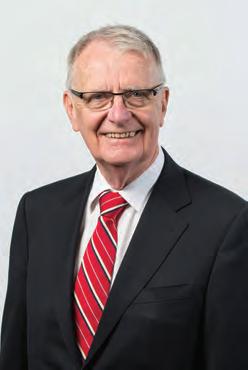

The directors of Hudson Institute of Medical Research Board, 31 December 2022

Board committees
Finance and Audit Committee
Mr Chris Dodd (Chair), Mr George Ou, Mr Rob Merriel (Secretary), Professor Elizabeth Hartland and Mr Alan Lahiff (Financial Comptroller)
Investment Committee
Mr Andrew Leyden (Chair), Mr Nigel Garrard (resigned December 2022), Mr Rob Merriel and Mr Alan Lahiff (Secretary)
Intellectual Property and Commercialisation Committee




Ms Zita Peach (Chair), Dr Andrew Gearing, Dr Alastair Hick, Dr Chris Smith, Dr Tony Eglezos, Mr Rob Merriel (Secretary), Professor Elizabeth Hartland, Professor Claudia Nold, Ms Carmela Monger (Business Development Manager), Dr Kate Mackin (Business Development Coordinator – resigned August 2022) and Mr Ryan Huang (Commercialisation Associate –commenced August 2022)
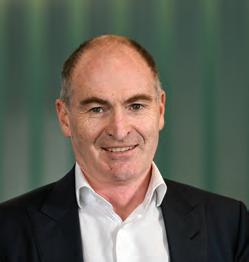


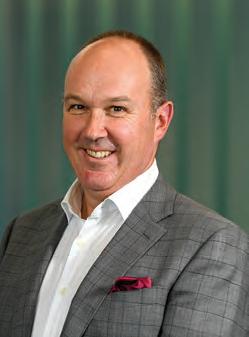 MR CHRIS DODD MBA, FCAANZ Chair, Finance and Audit Committee
MR ROB MERRIEL COMPANY SECRETARY BA, Grad Dip (Psych), Grad Dip (Accounting), CPA
PROFESSOR KIM CORNISH BS (Hons), PhD (London)
MS ZITA PEACH BSc, FAICD, FAMI Chair, Intellectual Property and Commercialisation Committee
PROFESSOR ANDREW STRIPP BOARD OBSERVER BBSc (Hons), MSc (Clinical Psychology)
PROFESSOR CHRISTINA MITCHELL AO MBBS, PhD, FRACP, FAHMS
PROFESSOR WARWICK ANDERSON AM BSc (Hons) UNE, PhD (Adelaide), DUniv (Adelaide), FAHA (Int), FRCPA (Hon), FAAHMS, DH (Newcastle)
MR NIGEL GARRARD BEcomm, AICD, CA Resigned: December 2022
MR ANDREW LEYDEN BComm Chair, Investment Committee
MR GEORGE OU MBA, CPA
MR CHRIS DODD MBA, FCAANZ Chair, Finance and Audit Committee
MR ROB MERRIEL COMPANY SECRETARY BA, Grad Dip (Psych), Grad Dip (Accounting), CPA
PROFESSOR KIM CORNISH BS (Hons), PhD (London)
MS ZITA PEACH BSc, FAICD, FAMI Chair, Intellectual Property and Commercialisation Committee
PROFESSOR ANDREW STRIPP BOARD OBSERVER BBSc (Hons), MSc (Clinical Psychology)
PROFESSOR CHRISTINA MITCHELL AO MBBS, PhD, FRACP, FAHMS
PROFESSOR WARWICK ANDERSON AM BSc (Hons) UNE, PhD (Adelaide), DUniv (Adelaide), FAHA (Int), FRCPA (Hon), FAAHMS, DH (Newcastle)
MR NIGEL GARRARD BEcomm, AICD, CA Resigned: December 2022
MR ANDREW LEYDEN BComm Chair, Investment Committee
MR GEORGE OU MBA, CPA
58 HUDSON INSTITUTE OF MEDICAL RESEARCH ANNUAL REPORT 2022 59
DR ROBERT (BOB) EDGAR AM BOARD CHAIR BEcon (Hons), PhD (Ohio State)












Victorian Government 7% Scientific and Laboratory 80% Philanthropic Grants 13% Investment Income 2% Other Income 3% Infrastructure Monash University 5% Commercial Research 10% Administration 20% Australian Government 60% Revenue 2022 ($) 2021($) 2020 ($) Australian Government 35,242,311 35,831,133 33,717,571 Philanthropic Grants 7,691,335 7,975,494 7,672,830 Commercial Research 5,745,228 5,539,265 5,374,502 Victorian Government 4,120,398 3,844,981 2,419,514 Infrastructure Monash University 3,061,489 3,702,044 3,207,348 Other Income 1,556,799 1,283,901 1,084,855 Investment Income 901,892 701,942 400,587 Total 58,319,452 58,878,760 53,877,208 Expenditure 2022 ($) 2021 ($) 2020 ($) Scientific and Laboratory 45,664,097 46,558,691 42,911,471 Administration Expenses* 11,534,862 11,465,389 9,952,501 Total 57,198,959 58,024,079 52,863,972 Financial snapshot Will you power our life-saving research by making a tax deductible donation today? *Administration Expenses include: special projects; salaries of administrative and scientific support staff; fundraising; communications; rent, utilities and buildings; information systems; professional services; legal patents and commercialisation; finance; and insurances. COMMITTEES Career DevelopmentCommittee Cultu e and Engagemen Committee EarlyCareerResearcherCommittee Education andTraining Committee Equity and Diversity Committee Ethics Committee Hudson Institu e Student Society OHSE Committee Research Committee Seminar Committee BOARD SUBCOMMITTEES Finance andAudit Committee Investment Committee Intellectual Property and Commercialisation Committee EXECUTIVE BOARD OF DIRECTORS CENTRE HEADS SCIENTIFIC SUPPORT GROUP Company Secretary Mr Rob Merriel Dr Joseph Pereira Deputy Director Professor Paul Hertzog Director and CEO Professor Elizabeth Hartland Finance Commercia isa ion and IP Research In egrity People and Culture OHSE Logistics and Technical Services LATS Platforms Purchasing Bioresources Centre for Cancer Research Professor Ron Firestein Centre for Reproductive Health Professor Kate Loveland The Ritchie Centre Professor Suzanne Miller Centre for Innate Immunity and Infectious Diseases Professor Brendan Jenkins Centre for Endocrinology and Metabolism Professor Peter Fuller Strategy Fundraising Communications Head of Fundraising and Communications MrGarry Tanner MsAnn Scott Organisation structure 60 HUDSON INSTITUTE OF MEDICAL RESEARCH ANNUAL REPORT 2022 61
















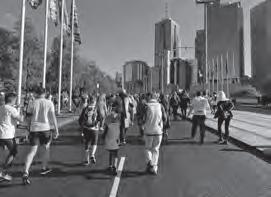



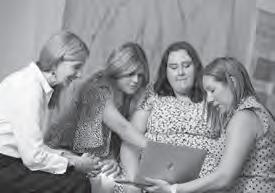



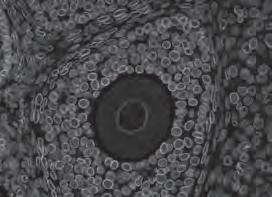























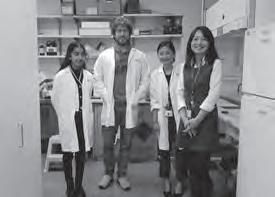










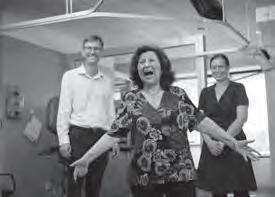




















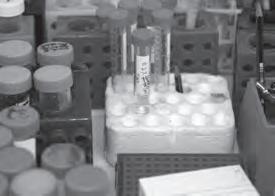










Yes, I will support groundbreaking medical research $100 $250 $500 My choice Cheque (made payable to ‘Hudson Institute of Medical Research’) Please deduct the ab ov e amount Once Annually Monthly Visa Mastercard AMEX Card number Cardholder’s name Signature Expiry date BLOCK LETTERS CVC Your gift of $2 and over is tax deductible. Please fill out this form and return in the enclosed reply paid envelope (Or make a secure online donation at hudson.org.au or by scanning the QR code below) t: +61 3 8572 2700 (9am-5pm) e: donations@hudson.org.au Please send me fu rther in f ormation about For all other enquiries, please contact us Remembering Hudson Institute in my Will (strictly con fidential) Making a regular, automated donation to Hudson Institute I have included a gift in my Will to Hudson Institute (strictly confidential) Yes, I would like to make a donation to groundbreaking medical research Title Name Address Suburb State Postcode Phone Email SURNAME FIRST My contact details Hudson Institute (ABN 48 132 025 024) protects your privacy in accordance with the information Privacy Principles of the Information Privacy Act 2000. AR2022 Please change my communications Please forward my receipt to Thank you, your donation is powering new treatments and cures! I only wish to receive Hudson News by email (as per my email details on this form) Please remove me from your mailing list My postal address My email address MMYY
t: +61 3 8572 2700 e: info@hudson.org.au w: hudson.org.au ABN 48 132 025 024 27-31 Wright Street Clayton VIC 3168 Australia




















































































 MR CHRIS DODD MBA, FCAANZ Chair, Finance and Audit Committee
MR ROB MERRIEL COMPANY SECRETARY BA, Grad Dip (Psych), Grad Dip (Accounting), CPA
PROFESSOR KIM CORNISH BS (Hons), PhD (London)
MS ZITA PEACH BSc, FAICD, FAMI Chair, Intellectual Property and Commercialisation Committee
PROFESSOR ANDREW STRIPP BOARD OBSERVER BBSc (Hons), MSc (Clinical Psychology)
PROFESSOR CHRISTINA MITCHELL AO MBBS, PhD, FRACP, FAHMS
PROFESSOR WARWICK ANDERSON AM BSc (Hons) UNE, PhD (Adelaide), DUniv (Adelaide), FAHA (Int), FRCPA (Hon), FAAHMS, DH (Newcastle)
MR NIGEL GARRARD BEcomm, AICD, CA Resigned: December 2022
MR ANDREW LEYDEN BComm Chair, Investment Committee
MR GEORGE OU MBA, CPA
MR CHRIS DODD MBA, FCAANZ Chair, Finance and Audit Committee
MR ROB MERRIEL COMPANY SECRETARY BA, Grad Dip (Psych), Grad Dip (Accounting), CPA
PROFESSOR KIM CORNISH BS (Hons), PhD (London)
MS ZITA PEACH BSc, FAICD, FAMI Chair, Intellectual Property and Commercialisation Committee
PROFESSOR ANDREW STRIPP BOARD OBSERVER BBSc (Hons), MSc (Clinical Psychology)
PROFESSOR CHRISTINA MITCHELL AO MBBS, PhD, FRACP, FAHMS
PROFESSOR WARWICK ANDERSON AM BSc (Hons) UNE, PhD (Adelaide), DUniv (Adelaide), FAHA (Int), FRCPA (Hon), FAAHMS, DH (Newcastle)
MR NIGEL GARRARD BEcomm, AICD, CA Resigned: December 2022
MR ANDREW LEYDEN BComm Chair, Investment Committee
MR GEORGE OU MBA, CPA






















































































































